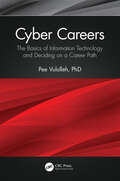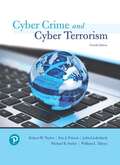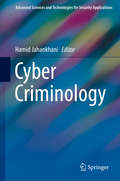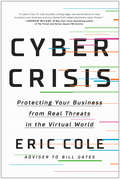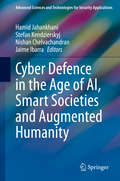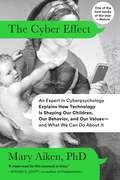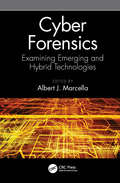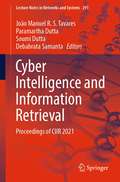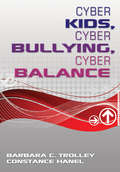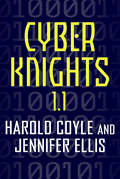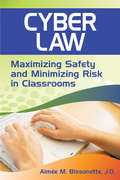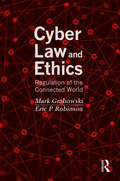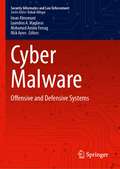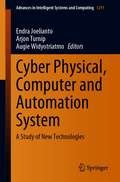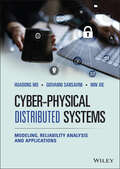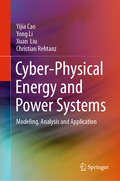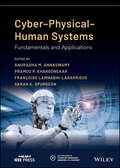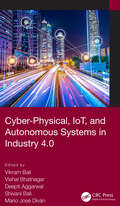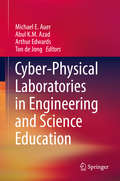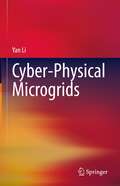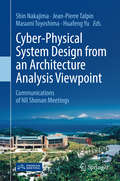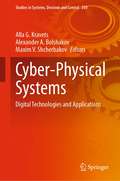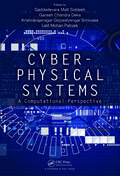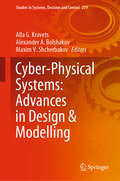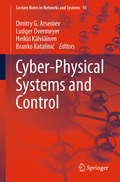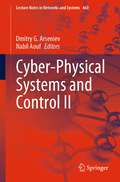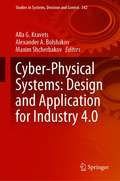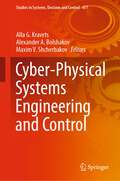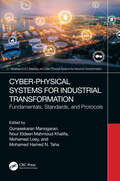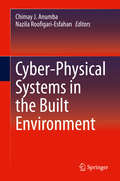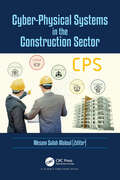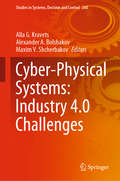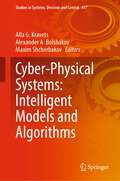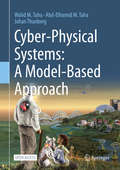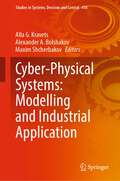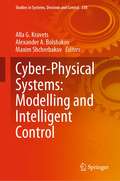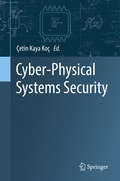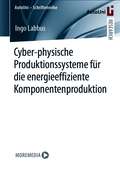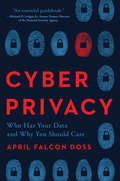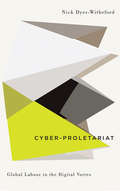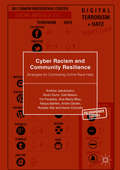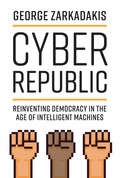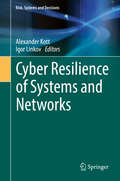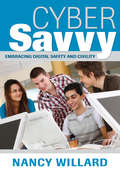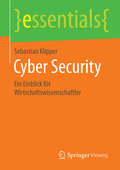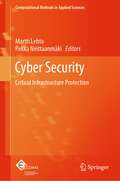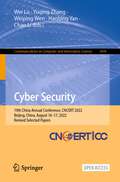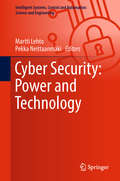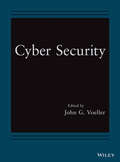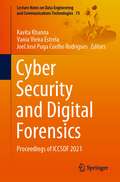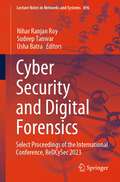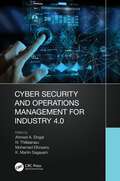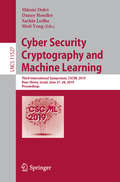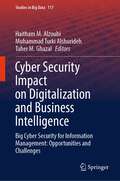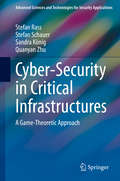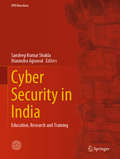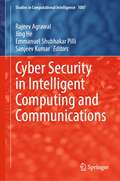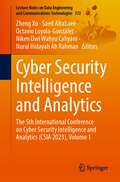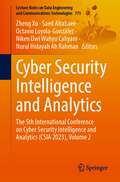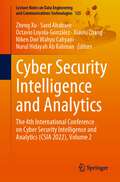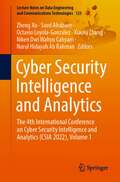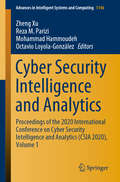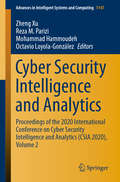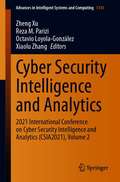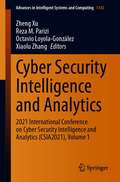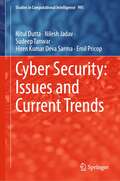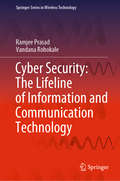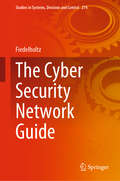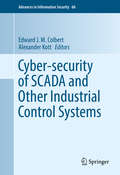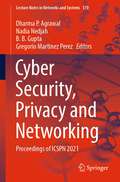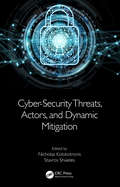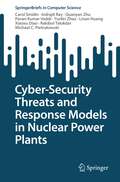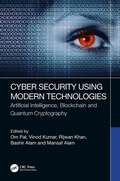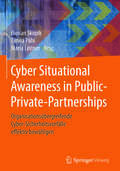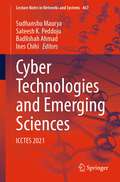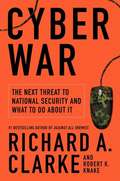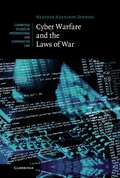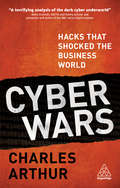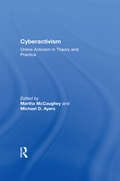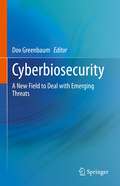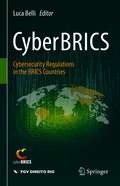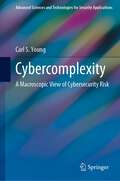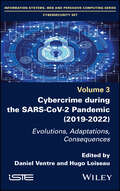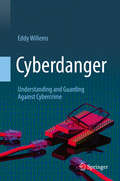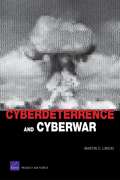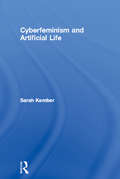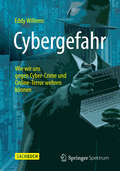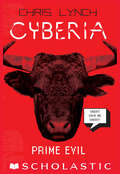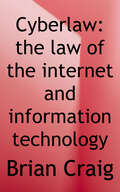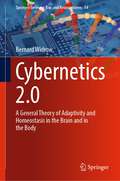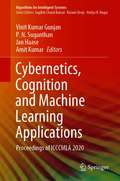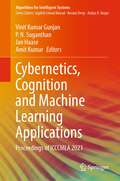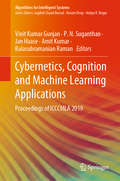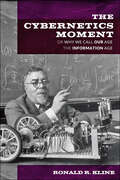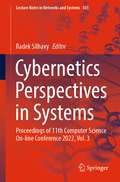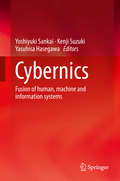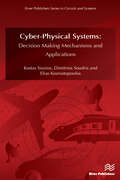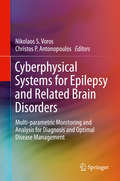- Table View
- List View
Cyber Careers: The Basics of Information Technology and Deciding on a Career Path
by Pee VulullehThe approach taken in this book emphasizes the basics of information technology and helps students decide whether to pursue an information technology career. Most students fail to pursue an IT career because of their limited knowledge (sometimes no knowledge) about the area. Similarly, most students pursuing a career in IT do not research the field before their pursuit. This book is purposely designed for students in this category. The book may be offered as a required text for an elective or core course to all bachelor's degree students regardless of specialization. Compared to other textbooks, this text guides students pursuing or wanting to pursue an IT degree/career. Most students often begin their study of IT without knowing the outside and inside of the area. Most of these students can change their minds to pursue a different career path after spending several semesters of studies, a waste of their time. If students are taught from the onset about what an IT career entails and what it takes to become successful, it will significantly help students and not waste their time. This book addresses the issue.
Cyber Crime and Cyber Terrorism
by Robert Taylor Eric Fritsch John Liederbach Michael Saylor William TafoyaThis book is a comprehensive introduction to the acts and theories of cyber crime, cyber terrorism, and information warfare. Assuming no prior knowledge of technology, the authors cover the types of crimes and terrorist acts committed using computer technology, theories addressing hackers and other digital criminals, and investigative, research, and legal strategies targeting these acts. Like no other on the market, the text bridges the gap between criminal justice knowledge and the technical issues that arise during investigations of cyber crime. The 4th edition adds material on new technologies and trends, plus updated review questions and activities.
Cyber Criminology (Advanced Sciences and Technologies for Security Applications)
by Hamid JahankhaniThis book provides a comprehensive overview of the current and emerging challenges of cyber criminology, victimization and profiling. It is a compilation of the outcomes of the collaboration between researchers and practitioners in the cyber criminology field, IT law and security field.As Governments, corporations, security firms, and individuals look to tomorrow’s cyber security challenges, this book provides a reference point for experts and forward-thinking analysts at a time when the debate over how we plan for the cyber-security of the future has become a major concern. Many criminological perspectives define crime in terms of social, cultural and material characteristics, and view crimes as taking place at a specific geographic location. This definition has allowed crime to be characterised, and crime prevention, mapping and measurement methods to be tailored to specific target audiences. However, this characterisation cannot be carried over to cybercrime, because the environment in which such crime is committed cannot be pinpointed to a geographical location, or distinctive social or cultural groups. Due to the rapid changes in technology, cyber criminals’ behaviour has become dynamic, making it necessary to reclassify the typology being currently used. Essentially, cyber criminals’ behaviour is evolving over time as they learn from their actions and others’ experiences, and enhance their skills. The offender signature, which is a repetitive ritualistic behaviour that offenders often display at the crime scene, provides law enforcement agencies an appropriate profiling tool and offers investigators the opportunity to understand the motivations that perpetrate such crimes. This has helped researchers classify the type of perpetrator being sought. This book offers readers insights into the psychology of cyber criminals, and understanding and analysing their motives and the methodologies they adopt. With an understanding of these motives, researchers, governments and practitioners can take effective measures to tackle cybercrime and reduce victimization.
Cyber Crisis: Protecting Your Business from Real Threats in the Virtual World
by Eric ColeBased on news reports, you might think there's a major cybersecurity threat every four to five months. In reality, there's a cybersecurity attack happening every minute of every day. Today, we live our lives—and conduct our business—online. Our data is in the cloud and in our pockets on our smartphones, shuttled over public Wi-Fi and company networks. To keep it safe, we rely on passwords and encryption and private servers, IT departments and best practices. But as you read this, there is a 70 percent chance that your data is compromised . . . you just don't know it yet. Cybersecurity attacks have increased exponentially, but because they're stealthy and often invisible, many underplay, ignore, or simply don't realize the danger. By the time they discover a breach, most individuals and businesses have been compromised for over three years. Instead of waiting until a problem surfaces, avoiding a data disaster means acting now to prevent one. In Cyber Crisis, Eric Cole gives readers a clear-eyed picture of the information war raging in cyberspace. Drawing on 30 years of experience—as a professional hacker for the CIA, as the Obama administration's cybersecurity commissioner, and as a consultant to clients around the globe from Bill Gates to Lockheed Martin and McAfee—Cole offers practical, actionable advice that even those with little technical background can implement, including steps to take on a daily, weekly, and monthly basis to protect their businesses and themselves. No matter who you are or where you work, cybersecurity should be a top priority. The information infrastructure we rely on in every sector of our lives—in healthcare and finance, for governments and private citizens—is both critical and vulnerable, and sooner or later, you or your company will be a target. This book is your guide to understanding the threat and putting together a proactive plan to minimize exposure and damage, and ensure the security of your business, your family, and your future
Cyber Defence in the Age of AI, Smart Societies and Augmented Humanity (Advanced Sciences and Technologies for Security Applications)
by Hamid Jahankhani Stefan Kendzierskyj Nishan Chelvachandran Jaime IbarraThis publication highlights the fast-moving technological advancement and infiltration of Artificial Intelligence into society. Concepts of evolution of society through interconnectivity are explored, together with how the fusion of human and technological interaction leading to Augmented Humanity is fast becoming more than just an endemic phase, but a cultural phase shift to digital societies. It aims to balance both the positive progressive outlooks such developments bring with potential issues that may stem from innovation of this kind, such as the invasive procedures of bio hacking or ethical connotations concerning the usage of digital twins. This publication will also give the reader a good level of understanding on fundamental cyber defence principles, interactions with Critical National Infrastructure (CNI) and the Command, Control, Communications and Intelligence (C3I) decision-making framework. A detailed view of the cyber-attack landscape will be garnered; touching on the tactics, techniques and procedures used, red and blue teaming initiatives, cyber resilience and the protection of larger scale systems. The integration of AI, smart societies, the human-centric approach and Augmented Humanity is discernible in the exponential growth, collection and use of [big] data; concepts woven throughout the diversity of topics covered in this publication; which also discusses the privacy and transparency of data ownership, and the potential dangers of exploitation through social media. As humans are become ever more interconnected, with the prolificacy of smart wearable devices and wearable body area networks, the availability of and abundance of user data and metadata derived from individuals has grown exponentially. The notion of data ownership, privacy and situational awareness are now at the forefront in this new age.
The Cyber Effect: A Pioneering Cyberpsychologist Explains How Human Behavior Changes Online (Not A Ser.)
by Mary AikenA groundbreaking exploration of how cyberspace is changing the way we think, feel, and behave Mary Aiken is the world's leading expert in forensic cyberpsychology--a discipline that combines psychology, criminology, and technology to investigate the intersection where technology and human behavior meet. In this, her first book, Aiken has created a starting point for all future conversations about how the Internet is shaping development and behavior, societal norms and values, children, safety, security, and our perception of the world. Cyberspace is an environment full of surveillance, but who is looking out for us? The Cyber Effect offers a fascinating and chilling look at a future we can still do something about. Drawing on her own research and extensive experience with law enforcement, Mary Aiken covers a wide range of subjects from the impact of screens on the developing child to the explosion of teen sexting, and the acceleration of compulsive and addictive behaviors online (gaming, shopping, pornography). She examines the escalation of cyberchondria (anxiety produced by self-diagnosing online), cyberstalking, and organized cybercrime in the Deep Web. Aiken provides surprising statistics and incredible-but-true case studies of hidden trends that are shaping our culture and raising troubling questions about where the digital revolution is taking us. The Cyber Effect will upend your assumptions about your online life and forever change the way you think about the technology you, your friends, and family use. Readers will gain a new understanding of the rapid change taking shape around us and come away with critical tools to become part of this very necessary conversation.Advance praise for The Cyber Effect"Just as Rachel Carson launched the modern environmental movement with her Silent Spring, Mary Aiken delivers a deeply disturbing, utterly penetrating, and urgently timed investigation into the perils of the largest unregulated social experiment of our time."--Bob Woodward "Mary Aiken takes us on a fascinating, thought-provoking, and at times scary journey down the rabbit hole to witness how the Internet is changing the human psyche. A must-read for anyone who wants to understand the temptations and tragedies of cyberspace."--John R. Suler, PhD, author of The Psychology of Cyberspace"Drawing on a fascinating and mind-boggling range of research and knowledge, Mary Aiken has written a great, important book that terrifies then consoles by pointing a way forward so that our experience online might not outstrip our common sense. A must-read for this moment in time."--Steven D. Levitt, co-author of the New York Times bestseller Freakonomics"Figuring out how to guide kids in a hyperconnected world is one of the biggest challenges for today's parents. Mary Aiken clearly and calmly separates reality from myth. She clearly lays out the issues we really need to be concerned about and calmly instructs us on how to keep our kids safe and healthy in their digital lives."--Peggy Orenstein, author of the New York Times bestseller Girls & Sex "Having worked with law enforcement groups from INTERPOL and Europol as well as the U.S. government, Aiken knows firsthand how today's digital tools can be exploited by criminals lurking in the Internet's Dark Net."--NewsweekFrom the Hardcover edition.
Cyber Forensics: Examining Emerging and Hybrid Technologies
by Albert J. MarcellaThreat actors, be they cyber criminals, terrorists, hacktivists or disgruntled employees, are employing sophisticated attack techniques and anti-forensics tools to cover their attacks and breach attempts. As emerging and hybrid technologies continue to influence daily business decisions, the proactive use of cyber forensics to better assess the risks that the exploitation of these technologies pose to enterprise-wide operations is rapidly becoming a strategic business objective. This book moves beyond the typical, technical approach to discussing cyber forensics processes and procedures. Instead, the authors examine how cyber forensics can be applied to identifying, collecting, and examining evidential data from emerging and hybrid technologies, while taking steps to proactively manage the influence and impact, as well as the policy and governance aspects of these technologies and their effect on business operations. A world-class team of cyber forensics researchers, investigators, practitioners and law enforcement professionals have come together to provide the reader with insights and recommendations into the proactive application of cyber forensic methodologies and procedures to both protect data and to identify digital evidence related to the misuse of these data. This book is an essential guide for both the technical and non-technical executive, manager, attorney, auditor, and general practitioner who is seeking an authoritative source on how cyber forensics may be applied to both evidential data collection and to proactively managing today’s and tomorrow’s emerging and hybrid technologies. The book will also serve as a primary or supplemental text in both under- and post-graduate academic programs addressing information, operational and emerging technologies, cyber forensics, networks, cloud computing and cybersecurity.
Cyber Intelligence and Information Retrieval: Proceedings of CIIR 2021 (Lecture Notes in Networks and Systems #291)
by João Manuel R. S. Tavares Paramartha Dutta Soumi Dutta Debabrata SamantaThis book gathers a collection of high-quality peer-reviewed research papers presented at International Conference on Cyber Intelligence and Information Retrieval (CIIR 2021), held at Institute of Engineering & Management, Kolkata, India during 20–21 May 2021. The book covers research papers in the field of privacy and security in the cloud, data loss prevention and recovery, high-performance networks, network security and cryptography, image and signal processing, artificial immune systems, information and network security, data science techniques and applications, data warehousing and data mining, data mining in dynamic environment, higher-order neural computing, rough set and fuzzy set theory, and nature-inspired computing techniques.
Cyber Kids, Cyber Bullying, Cyber Balance
by Constance Hanel Barbara C. TrolleyEmphasizing prevention, assessment, and evaluation, this proactive guide shows how to advance learning, reduce cyber bullying, and improve school climate by helping students use technology responsibly.
Cyber Knights 1.1
by Harold Coyle Jennifer EllisCyber Knights 1.1 is the second part in a stunning two-part collection of stories based on true-life cyber vulnerabilities, by Harold Coyle and Jennifer EllisHere be Dragons. In the Age of Discovery, unexplored areas of a map were often marked with this warning. Today, such a warning could easily be applied to the internet. Hackers and cyber assassins present a constant threat to individuals, companies, and institutions. Protecting these targets requires a new kind of warrior, a cyber knight armed with the skills, weapons, and savvy needed to slay today's dragons. One such digital warrior is Andy Webb, a former British Army officer. Together with Karen Spencer, a shy, twenty-something American who is a wizard when it comes to software, and Tommy Tyler, a rough and ready ex-soldier and hardware expert, Webb forms Century Consultants. The cyber security firm must work to defend its clients from the hackers, criminals and hired cyber assassins who seek out victims on the world wide web.
Cyber Law: Maximizing Safety and Minimizing Risk in Classrooms
by Aimee M. BissonetteAn essential overview of legal issues related to technology, this resource provides case summaries and proactive strategies on privacy, security, copyright, appropriate online behavior, and more.
Cyber Law and Ethics: Regulation of the Connected World
by Mark Grabowski Eric P. RobinsonA primer on legal issues relating to cyberspace, this textbook introduces business, policy and ethical considerations raised by our use of information technology. With a focus on the most significant issues impacting internet users and businesses in the United States of America, the book provides coverage of key topics such as social media, online privacy, artificial intelligence and cybercrime as well as emerging themes such as doxing, ransomware, revenge porn, data-mining, e-sports and fake news. The authors, experienced in journalism, technology and legal practice, provide readers with expert insights into the nuts and bolts of cyber law. Cyber Law and Ethics: Regulation of the Connected World provides a practical presentation of legal principles, and is essential reading for non-specialist students dealing with the intersection of the internet and the law.
Cyber Malware: Offensive and Defensive Systems (Security Informatics and Law Enforcement)
by Iman Almomani Leandros A. Maglaras Mohamed Amine Ferrag Nick AyresThis book provides the foundational aspects of malware attack vectors and appropriate defense mechanisms against malware. The book equips readers with the necessary knowledge and techniques to successfully lower the risk against emergent malware attacks. Topics cover protections against malware using machine learning algorithms, Blockchain and AI technologies, smart AI-based applications, automated detection-based AI tools, forensics tools, and much more. The authors discuss theoretical, technical, and practical issues related to cyber malware attacks and defense, making it ideal reading material for students, researchers, and developers.
Cyber Physical, Computer and Automation System: A Study of New Technologies (Advances in Intelligent Systems and Computing #1291)
by Endra Joelianto Arjon Turnip Augie WidyotriatmoThis book is a collection of extended papers presented at the Cyber Physical, Computer and Automation System (CPCAS 2019), Bali – Indonesia, 13–15 November 2019. The book includes chapters in three prime areas: (1) autonomous systems and controls; (2) human–machine interaction and human-related engineering; and (3) interconnected things. Autonomous systems and controls are systems of engineering that work with or without human intervention. Human–machine interaction involves sensor and actuator technology to detect human behavior, intentions, and decisions and also to provide the ability of a machine to interact with humans to achieve the expected performance. Interconnected things consist of a network of computer-controlled physical mechanisms communicating with each other for efficient operation and improving system capabilities.
Cyber-Physical Distributed Systems: Modeling, Reliability Analysis and Applications
by Huadong Mo Giovanni Sansavini Min XieCYBER-PHYSICAL DISTRIBUTED SYSTEMS Gather detailed knowledge and insights into cyber-physical systems behaviors from a cutting-edge reference written by leading voices in the field In Cyber-Physical Distributed Systems: Modeling, Reliability Analysis and Applications, distinguished researchers and authors Drs. Huadong Mo, Giovanni Sansavini, and Min Xie deliver a detailed exploration of the modeling and reliability analysis of cyber physical systems through applications in infrastructure and energy and power systems. The book focuses on the integrated modeling of systems that bring together physical and cyber elements and analyzing their stochastic behaviors and reliability with a view to controlling and managing them. The book offers a comprehensive treatment on the aging process and corresponding online maintenance, networked degradation, and cyber-attacks occurring in cyber-physical systems. The authors include many illustrative examples and case studies based on real-world systems and offer readers a rich set of references for further research and study. Cyber-Physical Distributed Systems covers recent advances in combinatorial models and algorithms for cyber-physical systems modeling and analysis. The book also includes: A general introduction to traditional physical/cyber systems, and the challenges, research trends, and opportunities for real cyber-physical systems applications that general readers will find interesting and useful Discussions of general modeling, assessment, verification, and optimization of industrial cyber-physical systems Explorations of stability analysis and enhancement of cyber-physical systems, including the integration of physical systems and open communication networks A detailed treatment of a system-of-systems framework for the reliability analysis and optimal maintenance of distributed systems with aging components Perfect for undergraduate and graduate students in computer science, electrical engineering, cyber security, industrial and system engineering departments, Cyber-Physical Distributed Systems will also earn a place on the bookshelves of students taking courses related to reliability, risk and control engineering from a system perspective. Reliability, safety and industrial control professionals will also benefit greatly from this book.
Cyber-Physical Energy and Power Systems: Modeling, Analysis and Application
by Yijia Cao Yong Li Xuan Liu Christian RehtanzThis book discusses recent advances in cyber-physical power systems (CPPS) in the modeling, analysis and applications of smart grid. It introduces a series of models, such as an analysis of interaction between the power grid and the communication network, differential protection in smart distribution systems, data flow for VLAN-based communication in substations, a co-simulation model for investigating the impacts of cyber-contingency and distributed control systems as well as the analytical techniques used in different parts of cyber physical energy systems. It also discusses methods of cyber-attack on power systems, particularly false data injection. The results presented are a comprehensive summary of the authors’ original research conducted over a period of 5 years. The book is of interest to university researchers, R&D engineers and graduate students in power and energy systems.
Cyber-Physical-Human Systems: Fundamentals and Applications (IEEE Press Series on Technology Management, Innovation, and Leadership)
by Anuradha M. Annaswamy Pramod P. Khargonekar Françoise Lamnabhi‐Lagarrigue Sarah K. SpurgeonCyber–Physical–Human Systems A comprehensive edited volume exploring the latest in the interactions between cyber–physical systems and humans In Cyber–Physical–Human Systems: Fundamentals and Applications, a team of distinguished researchers delivers a robust and up-to-date volume of contributions from leading researchers on Cyber–Physical–Human Systems, an emerging class of systems with increased interactions between cyber–physical, and human systems communicating with each other at various levels across space and time, so as to achieve desired performance related to human welfare, efficiency, and sustainability. The editors have focused on papers that address the power of emerging CPHS disciplines, all of which feature humans as an active component during cyber and physical interactions. Articles that span fundamental concepts and methods to various applications in engineering sectors of transportation, robotics, and healthcare and general socio-technical systems such as smart cities are featured. Together, these articles address challenges and opportunities that arise due to the emerging interactions between cyber–physical systems and humans, allowing readers to appreciate the intersection of cyber–physical system research and human behavior in large-scale systems. In the book, readers will also find: A thorough introduction to the fundamentals of cyber–physical–human systems In-depth discussions of cyber–physical–human systems with applications in transportation, robotics, and healthcare A comprehensive treatment of socio-technical systems, including social networks and smart cities Perfect for cyber–physical systems researchers, academics, and graduate students, Cyber–Physical–Human Systems: Fundamentals and Applications will also earn a place in the libraries of research and development professionals working in industry and government agencies.
Cyber-Physical, IoT, and Autonomous Systems in Industry 4.0
by Vikram Bali Vishal Bhatnagar Deepti Aggarwal Shivani Bali Mario José DivánThis book addresses topics related to the Internet of Things (IoT), machine learning, cyber-physical systems, cloud computing, and autonomous vehicles in Industry 4.0. It investigates challenges across multiple sectors and industries and considers Industry 4.0 for operations research and supply chain management.Cyber-Physical, IoT, and Autonomous Systems in Industry 4.0 encourages readers to develop novel theories and enrich their knowledge to foster sustainability. It examines the recent research trends and the future of cyber-physical systems, IoT, and autonomous systems as they relate to Industry 4.0. This book is intended for undergraduates, postgraduates, academics, researchers, and industry individuals to explore new ideas, techniques, and tools related to Industry 4.0.
Cyber-Physical Laboratories in Engineering and Science Education
by Michael E. Auer Arthur Edwards Ton De Jong Abul K.M. AzadThis volume investigates a number of issues needed to develop a modular, effective, versatile, cost effective, pedagogically-embedded, user-friendly, and sustainable online laboratory system that can deliver its true potential in the national and global arenas. This allows individual researchers to develop their own modular systems with a level of creativity and innovation while at the same time ensuring continuing growth by separating the responsibility for creating online laboratories from the responsibility for overseeing the students who use them. The volume first introduces the reader to several system architectures that have proven successful in many online laboratory settings. The following chapters then describe real-life experiences in the area of online laboratories from both technological and educational points of view. The volume further collects experiences and evidence on the effective use of online labs in the context of a diversity of pedagogical issues. It also illustrates successful online laboratories to highlight best practices as case studies and describes the technological design strategies, implementation details, and classroom activities as well as learning from these developments. Finally the volume describes the creation and deployment of commercial products, tools and services for online laboratory development. It also provides an idea about the developments that are on the horizon to support this area.
Cyber-Physical Microgrids
by Yan LiThis textbook provides students with an overview of cyber-physical microgrid networks and an in-depth introduction to photovoltaics, batteries, flywheel, supercapacitor, micro-turbines, wind generation, power-electronic interfaces, modeling and stability analysis of microgrids, and cyber-communication networks and security. The text helps upper-level undergraduate and graduate students gain a foundational understanding of microgrids and renewable energy, and offers an introduction to the frontier of theoretical research and practical applications of cyber-physical systems, paving the way to uncover and understand the operational mechanism of cyber-physical microgrids. The book includes examples and test systems throughout for problem-solving and will be an essential resource for students, researchers, and professionals in power engineering.
Cyber-Physical System Design from an Architecture Analysis Viewpoint: Communications of NII Shonan Meetings
by Jean-Pierre Talpin Shin Nakajima Masumi Toyoshima Huafeng YuProviding a wide variety of technologies for ensuring the safety and dependability of cyber-physical systems (CPS), this book offers a comprehensive introduction to the architecture-centric modeling, analysis, and verification of CPS. In particular, it focuses on model driven engineering methods including architecture description languages, virtual prototyping, and formal analysis methods. CPS are based on a new design paradigm intended to enable emerging software-intensive systems. Embedded computers and networks monitor and control the physical processes, usually with the help of feedback loops where physical processes affect computations and vice versa. The principal challenges in system design lie in this constant interaction of software, hardware and physics. Developing reliable CPS has become a critical issue for the industry and society, because many applications such as transportation, power distribution, medical equipment and tele-medicine are dependent on CPS. Safety and security requirements must be ensured by means of powerful validation tools. Satisfying such requirements, including quality of service, implies having formally proven the required properties of the system before it is deployed. The book is concerned with internationally standardized modeling languages such as AADL, SysML, and MARTE. As the effectiveness of the technologies is demonstrated with industrial sample cases from the automotive and aerospace sectors, links between the methods presented and industrial problems are clearly understandable. Each chapter is self-contained, addressing specific scientific or engineering problems, and identifying further issues. In closing, it includes perspectives on future directions in CPS design from an architecture analysis viewpoint.
Cyber-Physical Systems: Digital Technologies and Applications (Studies in Systems, Decision and Control #350)
by Alla G. Kravets Alexander A. Bolshakov Maxim V. ShcherbakovThis book offers ideas to help improve digital technologies and increase their efficiency during implementation and application for researchers and practitioners. The outstanding position of the book among others is that it dwells with cyber-physical systems’ progress and proposes ideas and finding around digital tools and technologies and their application. A distinguished contribution is in presenting results on Digital Twins development and application, enhancing approaches of communication and information transferring between cyber-physical systems connected within the Internet of things platforms, computer linguistic as a part of cyber-physical systems, intelligent cybersecurity and computer vision systems. The target audience of this book also includes practitioners and experts, as well as state authorities and representatives of manufacturing and industry who are interested in creating and implementing of cyber-physical systems in framework of digitalization projects.
Cyber-Physical Systems: A Computational Perspective
by Gaddadevara Matt Siddesh Ganesh Chandra Deka Krishnarajanagar GopalaIyengar Srinivasa Lalit Mohan PatnaikIn cyber-physical systems (CPS), sensors and embedded systems are networked together to monitor and manage a range of physical processes through a continuous feedback system. This allows distributed computing using wireless devices. Cyber-Physical Systems-A Computational Perspective examines various developments of CPS that are impacting our daily
Cyber-Physical Systems: Advances in Design & Modelling (Studies in Systems, Decision and Control #259)
by Alla G. Kravets Alexander A. Bolshakov Maxim V. ShcherbakovThis book presents new findings on cyber-physical systems design and modelling approaches based on AI and data-driven techniques, identifying the key industrial challenges and the main features of design and modelling processes. To enhance the efficiency of the design process, it proposes new approaches based on the concept of digital twins. Further, it substantiates the scientific, practical, and methodological approaches to modelling and simulating of cyber-physical systems. Exploring digital twins of cyber-physical systems as well as of production systems, it proposes combining both mathematical models and data processing techniques as advanced methods for cyber-physical system design and modelling. Moreover, it presents the implementation of the developed prototypes, including testing in real industries, which have collected and analyzed big data and proved their effectiveness. The book is intended for practitioners, enterprise representatives, scientists, and Ph.D. and master’s students interested in the research and applications of cyber-physical systems in different domains.
Cyber-Physical Systems and Control (Lecture Notes in Networks and Systems #95)
by Dmitry G. Arseniev Ludger Overmeyer Heikki Kälviäinen Branko KatalinićThis book presents the proceedings of the International Conference on Cyber-Physical Systems and Control (CPS&C'2019), held in Peter the Great St. Petersburg Polytechnic University, which is celebrating its 120th anniversary in 2019. The CPS&C'2019 was dedicated to the 35th anniversary of the partnership between Peter the Great St. Petersburg Polytechnic University and Leibniz University of Hannover. Cyber-physical systems (CPSs) are a new generation of control systems and techniques that help promote prospective interdisciplinary research. A wide range of theories and methodologies are currently being investigated and developed in this area to tackle various complex and challenging problems. Accordingly, CPSs represent a scientific and engineering discipline that is set to make an impact on future systems of industrial and social scale that are characterized by the deep integration of real-time processing, sensing, and actuation into logical and physical heterogeneous domains. The CPS&C'2019 brought together researchers and practitioners from all over the world and to discuss cross-cutting fundamental scientific and engineering principles that underline the integration of cyber and physical elements across all application fields. The participants represented research institutions and universities from Austria, Belgium, Bulgaria, China, Finland, Germany, the Netherlands, Russia, Syria, Ukraine, the USA, and Vietnam. These proceedings include 75 papers arranged into five sections, namely keynote papers, fundamentals, applications, technologies, and education and social aspects.
Cyber-Physical Systems and Control II (Lecture Notes in Networks and Systems #460)
by Dmitry G. Arseniev Nabil AoufThe book contains selected research papers presented at the 2nd International Conference on Cyber-Physical Systems and Control (CPS&C’2021) which was held from 29 June to 2 July 2021 in St. Petersburg, Russia. The CPS&C’2021 Conference continues the series of international conferences that began in 2019 when the first International Conference on Cyber-Physical Systems and Control (CPS&C’2019) took place. Cyber-physical systems (CPSs) considered a modern and rapidly emerging generation of systems with integrated wide computational, information processing, and physical capabilities that can interact with humans through many new modalities and application areas of implementation. The book covers the latest advances, developments and achievements in new theories, algorithms, models, and applications of prospective problems associated with CPSs with an emphasis on control theory and related areas. The multidisciplinary fundamental scientific and engineering principles that underpin the integration of cyber and physical elements across all application areas are discussed in the book chapters. The materials of the book may be of interest to scientists and engineers working in the field of cyber-physical systems, systems analysis, control systems, computer technologies, and similar fields.
Cyber-Physical Systems: Design and Application for Industry 4.0 (Studies in Systems, Decision and Control #342)
by Alla G. Kravets Alexander A. Bolshakov Maxim ShcherbakovThis book consists of chapters dedicated to the questions of cyber-physical system design and its usage for the chemical industry and new material design. Also, the contribution of the book covers scientific research and their results for cyber-physical systems design and application in the energy domain and solutions regarding engineering education for cyber-physical systems design. The book offers unique content for researchers and practitioners who are looking for new knowledge and skills in the framework of Industry 4.0 solutions. The book also benefits researchers and practitioners in chemistry and new material design and manufacturing to understand how cyber-physical systems can be applied to increase efficiency and performance. The target audience of the book are practitioners, enterprises representatives, scientists, Ph.D. and master students who perform scientific research or applications of cyber-physical systems in the concept of Industry 4.0.
Cyber-Physical Systems Engineering and Control (Studies in Systems, Decision and Control #477)
by Alla G. Kravets Alexander A. Bolshakov Maxim V. ShcherbakovThis book is devoted to the study of engineering and control technologies for the cyber-physical systems development. This book defines the approaches in the engineering leverage the exploitation of artificial intelligence and most urgent computing methods. The authors study the activities allows for the developing new and perspective concepts of robotics systems combining various machine learning methods, uncertainty explanation approaches, computer vision and unmanned aerial systems control technologies including artificial neural networks and simulation modeling by addressing a large scale of applications. The book also describes new materials engineering as well as implementation of these technologies in the different domains such as polymeric film production, polymer composition, and roller squeezing of leather, in order to realize the novel cyber-physical systems, their functionalities, and features. The authors describe the development of method for increasing the software efficiency, considering the increasing complexity of the computing systems and the importance of ensuring accuracy and velocity of modelling. The book also analyses algorithms for fuzzy models and systems, including the cyber-physical real-time systems, and non-stationary object with discrete time. The authors highlight the problem of ensuring the quality on engineering technologies for cyber-physical systems as the most important and consider different approaches to its solution.
Cyber-Physical Systems for Industrial Transformation: Fundamentals, Standards, and Protocols (Advances in IoT, Robotics, and Cyber Physical Systems for Industrial Transformation)
by Gunasekaran Manogaran Nour Eldeen M. Khalifa Mohamed Loey Mohamed Hamed N. TahaThis book investigates the fundaments, standards, and protocols of Cyber-Physical Systems (CPS) in the industrial transformation environment. It facilitates a fusion of both technologies in the creation of reliable and robust applications. Cyber-Physical Systems for Industrial Transformation: Fundamentals, Standards, and Protocols explores emerging technologies such as artificial intelligence, data science, blockchain, robotic process automation, virtual reality, edge computing, and 5G technology to highlight current and future opportunities to transition CPS to become more robust and reliable. The book showcases the real-time sensing, processing, and actuation software and discusses fault-tolerant and cybersecurity as well. This book brings together undergraduates, postgraduates, academics, researchers, and industry individuals that are interested in exploring new ideas, techniques, and tools related to CPS and Industry 4.0.
Cyber-Physical Systems in the Built Environment
by Chimay J. Anumba Nazila Roofigari-EsfahanThis book introduces researchers and practitioners to Cyber-Physical Systems (CPS) and its applications in the built environment. It begins with a fundamental introduction to CPS technology and associated concepts.It then presents numerous examples of applications from managing construction projects to smart transportation systems and smart cities. It concludes with a discussion of future directions for CPS deployment in the construction, operation and maintenance of constructed facilities. Featuring internationally recognized experts as contributors, Cyber-Physical Systems in the Built Environment, is an ideal resource for engineers, construction managers, architects, facilities managers, and planners working on a range of building and civil infrastructure projects.
Cyber-Physical Systems in the Construction Sector
by Wesam Salah AlaloulCyber-Physical Systems (CPSs) are mechanisms for monitoring and controlling processes using computer-based algorithms. In the construction industry, CPSs help to increase the viability of construction projects by reducing costs, time and management effort. This book aims to develop the fundamental concepts of construction project management associated with the CPSs and their applications within the modern construction industry in alignment with the scope of the Fourth Industrial Revolution (IR4.0). The book has been structured in a systematic way for easy understanding by construction industry researchers and academic faculty. The first part of the book helps readers to develop a basic understanding of the fundamental concepts of construction project management and CPSs. Followed by the second part about the CPSs implementation framework and understanding the operational concepts associated with the notion of IoT and Digital Twins within the construction industry. The third part of the book describes modelling/simulation techniques to develop the customised CPSs for construction project management. The concluding part provides an in-depth review of applications of CPSs, associated threats and security.
Cyber-Physical Systems: Industry 4.0 Challenges (Studies in Systems, Decision and Control #260)
by Alla G. Kravets Alexander A. Bolshakov Maxim V. ShcherbakovThis book presents new findings in industrial cyber-physical system design and control for various domains, as well as their social and economic impacts on society. Industry 4.0 requires new approaches in the context of secure connections, control, and maintenance of cyber-physical systems as well as enhancing their interaction with humans. The book focuses on open issues of cyber-physical system control and its usage, discussing implemented breakthrough systems, models, programs, and methods that could be used in industrial processes for the control, condition assessment, diagnostics, prognostication, and proactive maintenance of cyber-physical systems. Further, it addresses the topic of ensuring the cybersecurity of industrial cyber-physical systems and proposes new, reliable solutions. The authors also examine the impact of university courses on the performance of industrial complexes, and the organization of education for the development of cyber-physical systems. The book is intended for practitioners, enterprise representatives, scientists, students, and Ph.D. and master’s students conducting research in the area of cyber-physical system development and implementation in various domains.
Cyber-Physical Systems: Intelligent Models and Algorithms (Studies in Systems, Decision and Control #417)
by Alla G. Kravets Alexander A. Bolshakov Maxim ShcherbakovThis book is devoted to intelligent models and algorithms as the core components of cyber-physical systems. The complexity of cyber-physical systems developing and deploying requires new approaches to its modelling and design. Presents results in the field of modelling technologies that leverage the exploitation of artificial intelligence, including artificial general intelligence (AGI) and weak artificial intelligence. Provides scientific, practical, and methodological approaches based on bio-inspired methods, fuzzy models and algorithms, predictive modelling, computer vision and image processing. The target audience of the book are practitioners, enterprises representatives, scientists, PhD and Master students who perform scientific research or applications of intelligent models and algorithms in cyber-physical systems for various domains.
Cyber-Physical Systems: A Model-Based Approach
by Walid M. Taha Abd-Elhamid M. Taha Johan ThunbergIn this concise yet comprehensive Open Access textbook, future inventors are introduced to the key concepts of Cyber-Physical Systems (CPS). Using modeling as a way to develop deeper understanding of the computational and physical components of these systems, one can express new designs in a way that facilitates their simulation, visualization, and analysis. Concepts are introduced in a cross-disciplinary way. Leveraging hybrid (continuous/discrete) systems as a unifying framework and Acumen as a modeling environment, the book bridges the conceptual gap in modeling skills needed for physical systems on the one hand and computational systems on the other. In doing so, the book gives the reader the modeling and design skills they need to build smart, IT-enabled products. Starting with a look at various examples and characteristics of Cyber-Physical Systems, the book progresses to explain how the area brings together several previously distinct ones such as Embedded Systems, Control Theory, and Mechatronics. Featuring a simulation-based project that focuses on a robotics problem (how to design a robot that can play ping-pong) as a useful example of a CPS domain, Cyber-Physical Systems: A Model-Based Approach demonstrates the intimate coupling between cyber and physical components, and how designing robots reveals several non-trivial control problems, significant embedded and real-time computation requirements, and a need to consider issues of communication and preconceptions.
Cyber-Physical Systems: Modelling and Industrial Application (Studies in Systems, Decision and Control #418)
by Alla G. Kravets Alexander A. Bolshakov Maxim ShcherbakovThis book discusses the open questions regarding the modelling of cyber-physical systems and their application in different industries. The industry needs new approaches to improve its competitiveness. The concept of cyber-physical systems supports such changes, with the need to find new modelling tools becoming a key challenge. The book contains five-section covering the following topics: cyber-physical systems modelling, IoT and signal processing, cyber-physical systems intelligent control, cyber-physical systems industrial implementation and the production of the new material for cyber-physical systems. These approaches, on the one hand, should ensure the execution of current business processes, and on the other hand, ensure a quick speed of reactions to changes. The target audience of the book are practitioners, enterprises representatives, scientists, PhD and Master students who perform scientific research on modelling and industrial application of cyber-physical systems.
Cyber-Physical Systems: Modelling and Intelligent Control (Studies in Systems, Decision and Control #338)
by Alla G. Kravets Alexander A. Bolshakov Maxim ShcherbakovThis book highlights original approaches of modelling and intelligent control of cyber-physical systems covering both theoretical and practical aspects. The novel contribution of the book covers the transformation of scientific research and their results into applications for cyber-physical systems design and operation during the whole life cycle in different domains. Given its scope, the book offers an excellent reference book for researchers and other readers in the fields of cyber-physical systems modelling and intelligent control, space exploration and practical implementation of cyber-physical systems. The book also benefits researchers and practitioners in artificial intelligence and machine learning, as described results can be applied in cyber-physical systems design and cost-effectively maintenance. The target audience of this book also includes practitioners and experts, as well as state authorities and representatives of international organizations interested in creating mechanisms for implementing Cyber-Physical Systems projects.
Cyber-Physical Systems Security
by Çetin Kaya KoçThe chapters in this book present the work of researchers, scientists, engineers, and teachers engaged with developing unified foundations, principles, and technologies for cyber-physical security. They adopt a multidisciplinary approach to solving related problems in next-generation systems, representing views from academia, government bodies, and industrial partners, and their contributions discuss current work on modeling, analyzing, and understanding cyber-physical systems.
Cyber-physische Produktionssysteme für die energieeffiziente Komponentenproduktion (AutoUni – Schriftenreihe #152)
by Ingo LabbusDie vorliegende Dissertation präsentiert ein Konzept für den Einsatz cyber-physischer Produktionssysteme zur Steigerung der Energieeffizienz in der Komponentenproduktion. Das entwickelte Konzept integriert dafür Ansätze zu Datenmodellierung, -aufbereitung, und -analyse sowie Werkzeuge zur Planung energieeffizienter Produktionen. Dieses ermöglicht die Herstellung der Datendurchgängigkeit zwischen Planung und Betrieb der Produktion, erhöht die Transparenz über aktuelle Energiebedarfe sowie Einsparpotenziale und erleichtert so die Planung energieeffizienter Produktionen. Die Entwicklung und Anwendung des Konzeptes erfolgt am Beispiel der Fertigung von Komponenten für die Automobilproduktion.
Cyber Privacy: Who Has Your Data and Why You Should Care
by April Falcon Doss"Chilling, eye-opening, and timely, Cyber Privacy makes a strong case for the urgent need to reform the laws and policies that protect our personal data. If your reaction to that statement is to shrug your shoulders, think again. As April Falcon Doss expertly explains, data tracking is a real problem that affects every single one of us on a daily basis." —General Michael V. Hayden, USAF, Ret., former Director of CIA and NSA and former Principal Deputy Director of National Intelligence You're being tracked. Amazon, Google, Facebook, governments. No matter who we are or where we go, someone is collecting our data: to profile us, target us, assess us; to predict our behavior and analyze our attitudes; to influence the things we do and buy—even to impact our vote. If this makes you uneasy, it should. We live in an era of unprecedented data aggregation, and it's never been more difficult to navigate the trade-offs between individual privacy, personal convenience, national security, and corporate profits. Technology is evolving quickly, while laws and policies are changing slowly. You shouldn't have to be a privacy expert to understand what happens to your data. April Falcon Doss, a privacy expert and former NSA and Senate lawyer, has seen this imbalance in action. She wants to empower individuals and see policy catch up. In Cyber Privacy, Doss demystifies the digital footprints we leave in our daily lives and reveals how our data is being used—sometimes against us—by the private sector, the government, and even our employers and schools. She explains the trends in data science, technology, and the law that impact our everyday privacy. She tackles big questions: how data aggregation undermines personal autonomy, how to measure what privacy is worth, and how society can benefit from big data while managing its risks and being clear-eyed about its cost. It's high time to rethink notions of privacy and what, if anything, limits the power of those who are constantly watching, listening, and learning about us. This book is for readers who want answers to three questions: Who has your data? Why should you care? And most important, what can you do about it?
Cyber-Proletariat: Global Labour in the Digital Vortex
by Nick Dyer-WithefordThe utopian promise of the internet, much talked about even a few years ago, has given way to brutal realities: coltan mines in the Congo, electronics factories in China, devastated neighborhoods in Detroit. Cyber-Proletariat shows us the dark-side of the information revolution through an unsparing analysis of class power and computerization. Dyer-Witheford investigates how technology facilitates growing polarization between wealthy elites and precarious workers. He reveals the class domination behind everything from expanding online surveillance to intensifying robotization. At the same time, he looks at possibilities for information technology within radical movements.
Cyber Racism and Community Resilience: Strategies for Combating Online Race Hate (Palgrave Hate Studies)
by Karen Connelly Andrew Jakubowicz Kevin Dunn Gail Mason Yin Paradies Ana-Maria Bliuc Nasya Bahfen Andre Oboler Rosalie AtieThis book highlights cyber racism as an ever growing contemporary phenomenon. Its scope and impact reveals how the internet has escaped national governments, while its expansion is fuelling the spread of non-state actors. In response, the authors address the central question of this topic: What is to be done? Cyber Racism and Community Resilience demonstrates how the social sciences can be marshalled to delineate, comprehend and address the issues raised by a global epidemic of hateful acts against race. Authored by an inter-disciplinary team of researchers based in Australia, this book presents original data that reflects upon the lived, complex and often painful reality of race relations on the internet. It engages with the various ways, from the regulatory to the role of social activist, which can be deployed to minimise the harm often felt. This book will be of particular interest to students and academics in the fields of cybercrime, media sociology and cyber racism.
Cyber Republic: Reinventing Democracy in the Age of Intelligent Machines
by George ZarkadakisScience and tech expert George Zarkadakis presents an indispensable guide to making liberal democracies more inclusive, and the digital economy more equitable in the coming Fourth Industrial Revolution.Around the world, liberal democracies are in crisis. Citizens have lost faith in their government; right-wing nationalist movements frame the political debate. At the same time, economic inequality is increasing dramatically; digital technologies have created a new class of super-rich entrepreneurs. Automation threatens to transform the free economy into a zero-sum game in which capital wins and labor loses. But is this digital dystopia inevitable? In Cyber Republic, George Zarkadakis presents an alternative, outlining a plan for using technology to make liberal democracies more inclusive and the digital economy more equitable. Cyber Republic is no less than a guide for the coming Fourth Industrial Revolution.
Cyber Resilience of Systems and Networks (Risk, Systems and Decisions)
by Igor Linkov Alexander KottThis book introduces fundamental concepts of cyber resilience, drawing expertise from academia, industry, and government. Resilience is defined as the ability to recover from or easily adjust to shocks and stresses. Unlike the concept of security - which is often and incorrectly conflated with resilience -- resilience refers to the system's ability to recover or regenerate its performance after an unexpected impact produces a degradation in its performance. A clear understanding of distinction between security, risk and resilience is important for developing appropriate management of cyber threats. The book presents insightful discussion of the most current technical issues in cyber resilience, along with relevant methods and procedures. Practical aspects of current cyber resilience practices and techniques are described as they are now, and as they are likely to remain in the near term.The bulk of the material is presented in the book in a way that is easily accessible to non-specialists. Logical, consistent, and continuous discourse covering all key topics relevant to the field will be of use as teaching material as well as source of emerging scholarship in the field. A typical chapter provides introductory, tutorial-like material, detailed examples, in-depth elaboration of a selected technical approach, and a concise summary of key ideas.
Cyber Savvy: Embracing Digital Safety and Civility
by Dr Nancy E. WillardHow to teach students online safety and citizenship Nancy Willard integrates her expertise in risk prevention, law, and education to provide a collaborative and positive process for teaching secondary students positive social norms, safety, and “netiquette.” She lays out the steps for school staff and students to work as a team in building an effective program that will teach young people how to: Keep themselves safe Disclose and consume information wisely Respect the rights, privacy, and property of others Take responsibility for others’ well-being when needed Respond to inappropriate or dangerous situations
Cyber Security: Ein Einblick für Wirtschaftswissenschaftler (essentials)
by Sebastian KlipperIn diesem Buch erfahren Wirtschaftswissenschaftler, wie Firmen nach Hackerangriffen vom Markt verschwinden und wie Hacker Aktienkurse beeinflussen können. Lernen Sie, wie Homo oeconomicus beim Thema Cyber Security zum Homo carens securitate wird und wie es gelingt, mithilfe der wirtschaftswissenschaftlichen ,,Brille" (oder: Perspektive/Sicht) ganz neue Lösungsansätze und Sichtweisen im Kampf gegen Wirtschaftsspione, Hacker und Cyber-Kriminelle zu erkennen. Cyber Security bzw. IT-Sicherheit ist ein Zukunftsthema, an dem kaum jemand vorbeikommt. Dieses Buch beschreibt anhand aktueller Vorfälle - ohne technisches Grundwissen vorauszusetzen -, was Ökonomen wissen müssen, um sich am Gespräch über eines der wichtigsten Zukunftsthemen unserer Zeit beteiligen zu können.
Cyber Security: Critical Infrastructure Protection (Computational Methods in Applied Sciences #56)
by Martti Lehto Pekka NeittaanmäkiThis book focus on critical infrastructure protection. The chapters present detailed analysis of the issues and challenges in cyberspace and provide novel solutions in various aspects. The first part of the book focus on digital society, addressing critical infrastructure and different forms of the digitalization, strategic focus on cyber security, legal aspects on cyber security, citizen in digital society, and cyber security training. The second part focus on the critical infrastructure protection in different areas of the critical infrastructure. The chapters cover the cybersecurity situation awareness, aviation and air traffic control, cyber security in smart societies and cities, cyber security in smart buildings, maritime cyber security, cyber security in energy systems, and cyber security in healthcare. The third part presents the impact of new technologies upon cyber capability building as well as new challenges brought about by new technologies. These new technologies are among others are quantum technology, firmware and wireless technologies, malware analysis, virtualization.
Cyber Security: 19th China Annual Conference, CNCERT 2022, Beijing, China, August 16–17, 2022, Revised Selected Papers (Communications in Computer and Information Science #1699)
by Wei Lu Yuqing Zhang Weiping Wen Hanbing Yan Chao LiThis open access book constitutes the refereed proceedings of the 18th China Annual Conference on Cyber Security, CNCERT 2022, held in Beijing, China, in August 2022. The 17 papers presented were carefully reviewed and selected from 64 submissions. The papers are organized according to the following topical sections: data security; anomaly detection; cryptocurrency; information security; vulnerabilities; mobile internet; threat intelligence; text recognition.
Cyber Security: Power and Technology (Intelligent Systems, Control and Automation: Science and Engineering #93)
by Pekka Neittaanmäki Martti LehtoThis book gathers the latest research results of scientists from different countries who have made essential contributions to the novel analysis of cyber security. Addressing open problems in the cyber world, the book consists of two parts. Part I focuses on cyber operations as a new tool in global security policy, while Part II focuses on new cyber security technologies when building cyber power capabilities. The topics discussed include strategic perspectives on cyber security and cyber warfare, cyber security implementation, strategic communication, trusted computing, password cracking, systems security and network security among others.
Cyber Security
by John G. VoellerCyber Security features articles from the Wiley Handbook of Science and Technology for Homeland Security covering topics related to cyber security metrics and measure and related technologies that meet security needs. Specific applications to web services, the banking and the finance sector, and industrial process control systems are discussed.
Cyber Security and Digital Forensics: Proceedings of ICCSDF 2021 (Lecture Notes on Data Engineering and Communications Technologies #73)
by Kavita Khanna Vania Vieira Estrela Joel José Puga Coelho RodriguesThis book features high-quality research papers presented at the International Conference on Applications and Techniques in Cyber Security and Digital Forensics (ICCSDF 2021), held at The NorthCap University, Gurugram, Haryana, India, during April 3–4, 2021. This book discusses the topics ranging from information security to cryptography, mobile application attacks to digital forensics, and from cyber security to blockchain. The goal of the book is to provide 360-degree view of cybersecurity to the readers which include cyber security issues, threats, vulnerabilities, novel idea, latest technique and technology, and mitigation of threats and attacks along with demonstration of practical applications. This book also highlights the latest development, challenges, methodologies as well as other emerging areas in this field. It brings current understanding of common Web vulnerabilities while maintaining awareness and knowledge of contemporary standards, practices, procedures, and methods of Open Web Application Security Project. It also expounds how to recover information after a cybercrime.
Cyber Security and Digital Forensics: Select Proceedings of the International Conference, ReDCySec 2023 (Lecture Notes in Networks and Systems #896)
by Nihar Ranjan Roy Sudeep Tanwar Usha BatraThe book contains peer-reviewed papers from the International Conference on Recent Developments in Cyber Security organized by the Center for Cyber Security and Cryptology at Sharda University in June 2023. This volume focuses on privacy and secrecy of information, cryptography, applications and analysis, cyber threat intelligence and mitigation, cyber-physical systems, cyber threat intelligence, quantum cryptography and blockchain technologies and their application, etc. This book is a unique collection of chapters from different areas with a common theme and will be immensely useful to academic researchers and practitioners in the industry.
Cyber Security and Operations Management for Industry 4.0
by Ahmed A ElngarThis book seamlessly connects the topics of Industry 4.0 and cyber security. It discusses the risks and solutions of using cyber security techniques for Industry 4.0.Cyber Security and Operations Management for Industry 4.0 covers the cyber security risks involved in the integration of Industry 4.0 into businesses and highlights the issues and solutions. The book offers the latest theoretical and practical research in the management of cyber security issues common in Industry 4.0 and also discusses the ethical and legal perspectives of incorporating cyber security techniques and applications into the day-to-day functions of an organization. Industrial management topics related to smart factories, operations research, and value chains are also discussed.This book is ideal for industry professionals, researchers, and those in academia who are interested in learning more about how cyber security and Industry 4.0 are related and can work together.
Cyber Security Cryptography and Machine Learning: Third International Symposium, CSCML 2019, Beer-Sheva, Israel, June 27–28, 2019, Proceedings (Lecture Notes in Computer Science #11527)
by Shlomi Dolev Danny Hendler Sachin Lodha Moti YungThis book constitutes the refereed proceedings of the Third International Symposium on Cyber Security Cryptography and Machine Learning, CSCML 2019, held in Beer-Sheva, Israel, in June 2019.The 18 full and 10 short papers presented in this volume were carefully reviewed and selected from 36 submissions. They deal with the theory, design, analysis, implementation, or application of cyber security, cryptography and machine learning systems and networks, and conceptually innovative topics in these research areas.
Cyber Security Impact on Digitalization and Business Intelligence: Big Cyber Security for Information Management: Opportunities and Challenges (Studies in Big Data #117)
by Haitham M. Alzoubi Muhammad Turki Alshurideh Taher M. GhazalThis book takes a unique approach by exploring the connection between cybersecurity, digitalization, and business intelligence. In today's digital landscape, cybersecurity is a crucial aspect of business operations. Meanwhile, organizations continue to leverage digital technologies for their day-to-day operations. They must be aware of the risks associated with cyber-attacks and implement robust cybersecurity measures to protect their assets. It provides practical insights and solutions to help businesses better understand the impact of cybersecurity on their digitalization and business intelligence strategies. It provides practical insights and solutions for implementing cybersecurity measures in organizations and covers a wide range of topics, including threat intelligence, risk management, compliance, cloud security, and IoT security. The book takes a holistic approach and explores the intersection of cybersecurity, digitalization, and business intelligence and examines the possible challenges and opportunities.
Cyber-Security in Critical Infrastructures: A Game-Theoretic Approach (Advanced Sciences and Technologies for Security Applications)
by Quanyan Zhu Stefan Rass Stefan Schauer Sandra KönigThis book presents a compendium of selected game- and decision-theoretic models to achieve and assess the security of critical infrastructures. Given contemporary reports on security incidents of various kinds, we can see a paradigm shift to attacks of an increasingly heterogeneous nature, combining different techniques into what we know as an advanced persistent threat. Security precautions must match these diverse threat patterns in an equally diverse manner; in response, this book provides a wealth of techniques for protection and mitigation. Much traditional security research has a narrow focus on specific attack scenarios or applications, and strives to make an attack “practically impossible.” A more recent approach to security views it as a scenario in which the cost of an attack exceeds the potential reward. This does not rule out the possibility of an attack but minimizes its likelihood to the least possible risk. The book follows this economic definition of security, offering a management scientific view that seeks a balance between security investments and their resulting benefits. It focuses on optimization of resources in light of threats such as terrorism and advanced persistent threats. Drawing on the authors’ experience and inspired by real case studies, the book provides a systematic approach to critical infrastructure security and resilience. Presenting a mixture of theoretical work and practical success stories, the book is chiefly intended for students and practitioners seeking an introduction to game- and decision-theoretic techniques for security. The required mathematical concepts are self-contained, rigorously introduced, and illustrated by case studies. The book also provides software tools that help guide readers in the practical use of the scientific models and computational frameworks.
Cyber Security in India: Education, Research and Training (IITK Directions #4)
by Sandeep Kumar Shukla Manindra AgrawalThis book of 'directions' focuses on cyber security research, education and training in India, and work in this domain within the Indian Institute of Technology Kanpur. IIT Kanpur's Computer Science and Engineering Department established an ‘Interdisciplinary Center for Cyber Security and Cyber Defense of Critical Infrastructures (C3I Center)’ in 2016 with funding from the Science and Engineering Research Board (SERB), and other funding agencies. The work at the center focuses on smart grid security, manufacturing and other industrial control system security; network, web and data security; cryptography, and penetration techniques. The founders are involved with various Indian government agencies including the Reserve Bank of India, National Critical Information Infrastructure Protection Center, UIDAI, CCTNS under home ministry, Ministry of IT and Electronics, and Department of Science & Technology. The center also testifies to the parliamentary standing committee on cyber security, and has been working with the National Cyber Security Coordinator's office in India. Providing glimpses of the work done at IIT Kanpur, and including perspectives from other Indian institutes where work on cyber security is starting to take shape, the book is a valuable resource for researchers and professionals, as well as educationists and policymakers.
Cyber Security in Intelligent Computing and Communications (Studies in Computational Intelligence #1007)
by Rajeev Agrawal Jing He Emmanuel Shubhakar Pilli Sanjeev KumarThis book looks at cyber security challenges with topical advancements in computational intelligence and communication technologies. This book includes invited peer-reviewed chapters on the emerging intelligent computing and communication technology research advancements, experimental outcomes, and cyber security practices, threats, and attacks with challenges. The book begins with a state-of-the-art survey and reviews of cyber security trends and issues. It further covers areas such as developments in intelligent computing and communication, smart healthcare, agriculture, transportation, online education, and many more real-life applications using IoT, big data, cloud computing, artificial intelligence, data science, and machine learning. This book is of interest to graduate/postgraduate students, researchers, and academicians. This book will be a valuable resource for practitioners and professionals working in smart city visualization through secure and intelligent application design, development, deployment to foster digital revolution, and reliable integration of advanced computing and communication technologies with global significance.
Cyber Security Intelligence and Analytics: The 5th International Conference on Cyber Security Intelligence and Analytics (CSIA 2023), Volume 1 (Lecture Notes on Data Engineering and Communications Technologies #172)
by Zheng Xu Saed Alrabaee Octavio Loyola-González Niken Dwi Wahyu Cahyani Nurul Hidayah Ab RahmanThis book provides the proceedings of the 5th International Conference on Cyber Security Intelligence and Analytics. The 5th International Conference on Cyber Security Intelligence and Analytics (CSIA 2023) is an international conference dedicated to promoting novel theoretical and applied research advances in the interdisciplinary agenda of cyber security, particularly focusing on threat intelligence and analytics and countering cybercrime. Cyber security experts, including those in data analytics, incident response and digital forensics, need to be able to rapidly detect, analyze and defend against a diverse range of cyber threats in near real-time conditions. We are organizing the CSIA 2023 at Radisson Blu Shanghai Pudong Jinqiao Hotel. It will feature a technical program of refereed papers selected by the international program committee, keynote address.
Cyber Security Intelligence and Analytics: The 5th International Conference on Cyber Security Intelligence and Analytics (CSIA 2023), Volume 2 (Lecture Notes on Data Engineering and Communications Technologies #173)
by Zheng Xu Saed Alrabaee Octavio Loyola-González Niken Dwi Wahyu Cahyani Nurul Hidayah Ab RahmanThis book provides the proceedings of the 5th International Conference on Cyber Security Intelligence and Analytics. The 5th International Conference on Cyber Security Intelligence and Analytics (CSIA 2023) is an international conference dedicated to promoting novel theoretical and applied research advances in the interdisciplinary agenda of cyber security, particularly focusing on threat intelligence and analytics and countering cybercrime. Cyber security experts, including those in data analytics, incident response and digital forensics, need to be able to rapidly detect, analyze and defend against a diverse range of cyber threats in near real-time conditions. We are organizing the CSIA 2023 at Radisson Blu Shanghai Pudong Jinqiao Hotel. It will feature a technical program of refereed papers selected by the international program committee, keynote address.
Cyber Security Intelligence and Analytics: The 4th International Conference on Cyber Security Intelligence and Analytics (CSIA 2022), Volume 2 (Lecture Notes on Data Engineering and Communications Technologies #125)
by Zheng Xu Saed Alrabaee Octavio Loyola-González Xiaolu Zhang Niken Dwi Wahyu Cahyani Nurul Hidayah Ab RahmanThis book presents the outcomes of the 2022 4th International Conference on Cyber Security Intelligence and Analytics (CSIA 2022), an international conference dedicated to promoting novel theoretical and applied research advances in the interdisciplinary field of cyber-security, particularly focusing on threat intelligence, analytics, and countering cyber-crime. The conference provides a forum for presenting and discussing innovative ideas, cutting-edge research findings and novel techniques, methods and applications on all aspects of cyber-security intelligence and analytics. Due to COVID-19, authors, keynote speakers and PC committees will attend the conference online.
Cyber Security Intelligence and Analytics: The 4th International Conference on Cyber Security Intelligence and Analytics (CSIA 2022), Volume 1 (Lecture Notes on Data Engineering and Communications Technologies #123)
by Zheng Xu Saed Alrabaee Octavio Loyola-González Xiaolu Zhang Niken Dwi Wahyu Cahyani Nurul Hidayah Ab RahmanThis book presents the outcomes of the 2022 4th International Conference on Cyber Security Intelligence and Analytics (CSIA 2022), an international conference dedicated to promoting novel theoretical and applied research advances in the interdisciplinary field of cyber-security, particularly focusing on threat intelligence, analytics, and countering cyber-crime. The conference provides a forum for presenting and discussing innovative ideas, cutting-edge research findings and novel techniques, methods and applications on all aspects of cyber-security intelligence and analytics. Due to COVID-19, authors, keynote speakers and PC committees will attend the conference online.
Cyber Security Intelligence and Analytics: Proceedings of the 2020 International Conference on Cyber Security Intelligence and Analytics (CSIA 2020), Volume 1 (Advances in Intelligent Systems and Computing #1146)
by Zheng Xu Mohammad Hammoudeh Reza M. Parizi Octavio Loyola-GonzálezThis book presents the outcomes of the 2020 International Conference on Cyber Security Intelligence and Analytics (CSIA 2020), which was dedicated to promoting novel theoretical and applied research advances in the interdisciplinary field of cyber security, particularly those focusing on threat intelligence, analytics, and preventing cyber crime. The conference provides a forum for presenting and discussing innovative ideas, cutting-edge research findings, and novel techniques, methods, and applications concerning all aspects of cyber security intelligence and analytics. CSIA 2020, which was held in Haikou, China on February 28–29, 2020, built on the previous conference in Wuhu, China (2019), and marks the series’ second successful installment.
Cyber Security Intelligence and Analytics: Proceedings of the 2020 International Conference on Cyber Security Intelligence and Analytics (CSIA 2020), Volume 2 (Advances in Intelligent Systems and Computing #1147)
by Zheng Xu Mohammad Hammoudeh Reza M. Parizi Octavio Loyola-GonzálezThis book presents the outcomes of the 2020 International Conference on Cyber Security Intelligence and Analytics (CSIA 2020), an international conference dedicated to promoting novel theoretical and applied research advances in the interdisciplinary field of cyber security, particularly focusing on threat intelligence, analytics, and countering cyber crime. The conference provides a forum for presenting and discussing innovative ideas, cutting-edge research findings, and novel techniques, methods and applications on all aspects of Cyber Security Intelligence and Analytics. The 2020 International Conference on Cyber Security Intelligence and Analytics (CSIA 2020) is held at Feb. 28-29, 2020, in Haikou, China, building on the previous successes in Wuhu, China (2019) is proud to be in the 2nd consecutive conference year.
Cyber Security Intelligence and Analytics: 2021 International Conference on Cyber Security Intelligence and Analytics (CSIA2021), Volume 2 (Advances in Intelligent Systems and Computing #1343)
by Zheng Xu Reza M. Parizi Octavio Loyola-González Xiaolu ZhangThis book presents the outcomes of the 2021 International Conference on Cyber Security Intelligence and Analytics (CSIA 2021), an international conference dedicated to promoting novel theoretical and applied research advances in the interdisciplinary field of cyber security, particularly focusing on threat intelligence, analytics, and countering cybercrime. The conference provides a forum for presenting and discussing innovative ideas, cutting-edge research findings and novel techniques, methods and applications on all aspects of cyber security intelligence and analytics. Due to COVID-19, Authors, Keynote Speakers and PC committees will attend the conference online.
Cyber Security Intelligence and Analytics: 2021 International Conference on Cyber Security Intelligence and Analytics (CSIA2021), Volume 1 (Advances in Intelligent Systems and Computing #1342)
by Zheng Xu Reza M. Parizi Octavio Loyola-González Xiaolu ZhangThis book presents the outcomes of the 2021 International Conference on Cyber Security Intelligence and Analytics (CSIA 2021), an international conference dedicated to promoting novel theoretical and applied research advances in the interdisciplinary field of cyber security, particularly focusing on threat intelligence, analytics, and countering cybercrime. The conference provides a forum for presenting and discussing innovative ideas, cutting-edge research findings and novel techniques, methods and applications on all aspects of cyber security intelligence and analytics. Due to COVID-19, Authors, Keynote Speakers and PC committees will attend the conference online.
Cyber Security: Issues and Current Trends (Studies in Computational Intelligence #995)
by Nitul Dutta Nilesh Jadav Sudeep Tanwar Hiren Kumar Sarma Emil PricopThis book presents various areas related to cybersecurity. Different techniques and tools used by cyberattackers to exploit a system are thoroughly discussed and analyzed in their respective chapters. The content of the book provides an intuition of various issues and challenges of cybersecurity that can help readers to understand and have awareness about it. It starts with a very basic introduction of security, its varied domains, and its implications in any working organization; moreover, it will talk about the risk factor of various attacks and threats. The concept of privacy and anonymity has been taken into consideration in consecutive chapters. Various topics including, The Onion Router (TOR) and other anonymous services, are precisely discussed with a practical approach. Further, chapters to learn the importance of preventive measures such as intrusion detection system (IDS) are also covered. Due to the existence of severe cyberattacks, digital forensics is a must for investigating the crime and to take precautionary measures for the future occurrence of such attacks. A detailed description of cyberinvestigation is covered in a chapter to get readers acquainted with the need and demands. This chapter deals with evidence collection from the victim's device and the system that has importance in the context of an investigation. Content covered in all chapters is foremost and reported in the current trends in several journals and cybertalks. The proposed book is helpful for any reader who is using a computer or any such electronic gadget in their daily routine. The content of the book is prepared to work as a resource to any undergraduate and graduate-level student to get aware about the concept of cybersecurity, various cyberattacks, and threats in the security. In addition to that, it aimed at assisting researchers and developers to build a strong foundation for security provisioning in any newer technology which they are developing.
Cyber Security: The Lifeline of Information and Communication Technology (Springer Series in Wireless Technology)
by Ramjee Prasad Vandana RohokaleThis book discusses a broad range of cyber security issues, addressing global concerns regarding cyber security in the modern era. The growth of Information and Communication Technology (ICT) and the prevalence of mobile devices make cyber security a highly topical and relevant issue. The transition from 4G to 5G mobile communication, while bringing convenience, also means cyber threats are growing exponentially. This book discusses a variety of problems and solutions including: • Internet of things and Machine to Machine Communication; • Infected networks such as Botnets; • Social media and networking; • Cyber Security for Smart Devices and Smart Grid • Blockchain Technology and • Artificial Intelligence for Cyber Security Given its scope, the book offers a valuable asset for cyber security researchers, as well as industry professionals, academics, and students.
The Cyber Security Network Guide (Studies in Systems, Decision and Control #274)
by FiedelholtzThis book presents a unique, step-by-step approach for monitoring, detecting, analyzing and mitigating complex network cyber threats. It includes updated processes in response to asymmetric threats, as well as descriptions of the current tools to mitigate cyber threats. Featuring comprehensive computer science material relating to a complete network baseline with the characterization hardware and software configuration, the book also identifies potential emerging cyber threats and the vulnerabilities of the network architecture to provide students with a guide to responding to threats. The book is intended for undergraduate and graduate college students who are unfamiliar with the cyber paradigm and processes in responding to attacks.
Cyber-security of SCADA and Other Industrial Control Systems (Advances in Information Security #66)
by Alexander Kott Edward J. M. ColbertThis book provides a comprehensive overview of the fundamental security of Industrial Control Systems (ICSs), including Supervisory Control and Data Acquisition (SCADA) systems and touching on cyber-physical systems in general. Careful attention is given to providing the reader with clear and comprehensive background and reference material for each topic pertinent to ICS security. This book offers answers to such questions as: Which specific operating and security issues may lead to a loss of efficiency and operation? What methods can be used to monitor and protect my system? How can I design my system to reduce threats? This book offers chapters on ICS cyber threats, attacks, metrics, risk, situational awareness, intrusion detection, and security testing, providing an advantageous reference set for current system owners who wish to securely configure and operate their ICSs. This book is appropriate for non-specialists as well. Tutorial information is provided in two initial chapters and in the beginnings of other chapters as needed. The book concludes with advanced topics on ICS governance, responses to attacks on ICS, and future security of the Internet of Things.
Cyber Security, Privacy and Networking: Proceedings of ICSPN 2021 (Lecture Notes in Networks and Systems #370)
by Dharma P. Agrawal Nadia Nedjah B. B. Gupta Gregorio Martinez PerezThis book covers selected high-quality research papers presented in the International Conference on Cyber Security, Privacy and Networking (ICSPN 2021), organized during 17-19 September 2021 in India in Online mode. The objectives of ICSPN 2021 is to provide a premier international platform for deliberations on strategies, recent trends, innovative approaches, discussions and presentations on the most recent cyber security, privacy and networking challenges and developments from the perspective of providing security awareness and its best practices for the real world. Moreover, the motivation to organize this conference is to promote research by sharing innovative ideas among all levels of the scientific community, and to provide opportunities to develop creative solutions to various security, privacy and networking problems.
Cyber-Security Threats, Actors, and Dynamic Mitigation
by Nicholas Kolokotronis Stavros ShiaelesCyber-Security Threats, Actors, and Dynamic Mitigation provides both a technical and state-of-the-art perspective as well as a systematic overview of the recent advances in different facets of cyber-security. It covers the methodologies for modeling attack strategies used by threat actors targeting devices, systems, and networks such as smart homes, critical infrastructures, and industrial IoT. With a comprehensive review of the threat landscape, the book explores both common and sophisticated threats to systems and networks. Tools and methodologies are presented for precise modeling of attack strategies, which can be used both proactively in risk management and reactively in intrusion prevention and response systems. Several contemporary techniques are offered ranging from reconnaissance and penetration testing to malware detection, analysis, and mitigation. Advanced machine learning-based approaches are also included in the area of anomaly-based detection, that are capable of detecting attacks relying on zero-day vulnerabilities and exploits. Academics, researchers, and professionals in cyber-security who want an in-depth look at the contemporary aspects of the field will find this book of interest. Those wanting a unique reference for various cyber-security threats and how they are detected, analyzed, and mitigated will reach for this book often.
Cyber-Security Threats and Response Models in Nuclear Power Plants (SpringerBriefs in Computer Science)
by Carol Smidts Indrajit Ray Quanyan Zhu Pavan Kumar Vaddi Yunfei Zhao Linan Huang Xiaoxu Diao Rakibul Talukdar Michael C. PietrykowskiThis SpringerBrief presents a brief introduction to probabilistic risk assessment (PRA), followed by a discussion of abnormal event detection techniques in industrial control systems (ICS). It also provides an introduction to the use of game theory for the development of cyber-attack response models and a discussion on the experimental testbeds used for ICS cyber security research. The probabilistic risk assessment framework used by the nuclear industry provides a valid framework to understand the impacts of cyber-attacks in the physical world. An introduction to the PRA techniques such as fault trees, and event trees is provided along with a discussion on different levels of PRA and the application of PRA techniques in the context of cybersecurity. A discussion on machine learning based fault detection and diagnosis (FDD) methods and cyber-attack detection methods for industrial control systems are introduced in this book as well.A dynamic Bayesian networks based method that can be used to detect an abnormal event and classify it as either a component fault induced safety event or a cyber-attack is discussed. An introduction to the stochastic game formulation of the attacker-defender interaction in the context of cyber-attacks on industrial control systems to compute optimal response strategies is presented. Besides supporting cyber-attack response, the analysis based on the game model also supports the behavioral study of the defender and the attacker during a cyber-attack, and the results can then be used to analyze the risk to the system caused by a cyber-attack. A brief review of the current state of experimental testbeds used in ICS cybersecurity research and a comparison of the structures of various testbeds and the attack scenarios supported by those testbeds is included. A description of a testbed for nuclear power applications, followed by a discussion on the design of experiments that can be carried out on the testbed and the associated results is covered as well.This SpringerBrief is a useful resource tool for researchers working in the areas of cyber security for industrial control systems, energy systems and cyber physical systems. Advanced-level students that study these topics will also find this SpringerBrief useful as a study guide.
Cyber Security Using Modern Technologies: Artificial Intelligence, Blockchain and Quantum Cryptography
by Om Pal Vinod Kumar Rijwan Khan Bashir Alam Mansaf AlamThe main objective of this book is to introduce cyber security using modern technologies such as Artificial Intelligence, Quantum Cryptography, and Blockchain. This book provides in-depth coverage of important concepts related to cyber security. Beginning with an introduction to Quantum Computing, Post-Quantum Digital Signatures, and Artificial Intelligence for cyber security of modern networks and covering various cyber-attacks and the defense measures, strategies, and techniques that need to be followed to combat them, this book goes on to explore several crucial topics, such as security of advanced metering infrastructure in smart grids, key management protocols, network forensics, intrusion detection using machine learning, cloud computing security risk assessment models and frameworks, cyber-physical energy systems security, a biometric random key generator using deep neural network and encrypted network traffic classification. In addition, this book provides new techniques to handle modern threats with more intelligence. It also includes some modern techniques for cyber security, such as blockchain for modern security, quantum cryptography, and forensic tools. Also, it provides a comprehensive survey of cutting-edge research on the cyber security of modern networks, giving the reader a general overview of the field. It also provides interdisciplinary solutions to protect modern networks from any type of attack or manipulation. The new protocols discussed in this book thoroughly examine the constraints of networks, including computation, communication, and storage cost constraints, and verifies the protocols both theoretically and experimentally. Written in a clear and comprehensive manner, this book would prove extremely helpful to readers. This unique and comprehensive solution for the cyber security of modern networks will greatly benefit researchers, graduate students, and engineers in the fields of cryptography and network security.
Cyber Situational Awareness in Public-Private-Partnerships: Organisationsübergreifende Cyber-Sicherheitsvorfälle effektiv bewältigen
by Florian Skopik Tímea Páhi Maria LeitnerDigitale Dienste werden für unsere Gesellschaft immer wichtiger, daher gelangen sie auch stärker ins Visier von Wirtschaftskriminellen, Spionen, Terroristen oder staatsfeindlichen Gruppierungen. Wie schützen sich Unternehmen und Staaten vor solchen Cyber-Attacken? Ein wichtiger Grundstein ist die Schaffung von Behörden, wie sie die EU-Richtlinie über Maßnahmen zur Gewährleistung eines hohen gemeinsamen Sicherheitsniveaus von Netz- und Informationssystemen (NIS) vorsieht. Das Buch zeigt, wie sich die Zusammenarbeit von Unternehmen mit diesen NIS-Behörden gestaltet mit dem gemeinsamen Ziel, Cyber-Sicherheit zu etablieren und zu gewährleisten. Darüber hinaus legen die Autoren dar, wie sich die NIS-Richtlinie und die im Mai 2018 in Kraft getretene EU-Datenschutz-Grundverordnung (DSGVO) auf Security-Prozesse in Unternehmen auswirken können. Das Buch verknüpft technische, organisatorische und rechtliche Aspekte der Zusammenarbeit und spiegelt damit die Komplexität des Themas wider. Zugleich liefert es zahlreiche Vorschläge zur Umsetzung der EU-Richtlinie. Im Mittelpunkt steht dabei das Konzept der „Cyber Situational Awareness“ – das bewusste Erfassen der aktuellen Lage – und damit ein Instrument, mit dem sich die Reaktionsfähigkeit bei Cyber-Angriffen wesentlich erhöhen lässt. Folgende Themen werden erläutert: • Aufbau und Nutzung von Cyber Situational Awareness • Erstellung von Cyber-Lagebildern auf nationaler Ebene • Informations- und Datenquellen für Cyber-Lagebilder• Informationsaustausch zwischen Cyber-Lagezentren und Stakeholdern • Informations- und Meldepflichten von Unternehmen• Planspiel zur Bildung und Evaluierung von Cyber Situational Awareness
Cyber Technologies and Emerging Sciences: ICCTES 2021 (Lecture Notes in Networks and Systems #467)
by Sudhanshu Maurya Sateesh K. Peddoju Badlishah Ahmad Ines ChihiThe book is a collection of best selected research papers presented at International Conference on Cyber-Technologies and Emerging Sciences (ICCTES 2021), organized by Graphic Era Hill University, Bhimtal Campus, Uttarakhand, India, during 17 – 18 December 2021. The book covers state-of-the-art applications, innovative methods, and analyze the unexplored and unsolved challenges to establish the relative solutions to advance the existing applications and theories of Cyber-Technologies and Emerging Sciences.
Cyber War: The Next Threat to National Security and What to Do About It
by Richard A. Clarke Robert KnakeRichard A. Clarke warned America once before about the havoc terrorism would wreak on our national security--and he was right. Now he warns us of another threat, silent but equally dangerous. Cyber War is a powerful book about technology, government, and military strategy; about criminals, spies, soldiers, and hackers. This is the first book about the war of the future--cyber war--and a convincing argument that we may already be in peril of losing it. Cyber War goes behind the "geek talk" of hackers and computer scientists to explain clearly and convincingly what cyber war is, how cyber weapons work, and how vulnerable we are as a nation and as individuals to the vast and looming web of cyber criminals. From the first cyber crisis meeting in the White House a decade ago to the boardrooms of Silicon Valley and the electrical tunnels under Manhattan, Clarke and coauthor Robert K. Knake trace the rise of the cyber age and profile the unlikely characters and places at the epicenter of the battlefield. They recount the foreign cyber spies who hacked into the office of the Secretary of Defense, the control systems for U.S. electric power grids, and the plans to protect America's latest fighter aircraft. Economically and militarily, Clarke and Knake argue, what we've already lost in the new millennium's cyber battles is tantamount to the Soviet and Chinese theft of our nuclear bomb secrets in the 1940s and 1950s. The possibilities of what we stand to lose in an all-out cyber war--our individual and national security among them-- are just as chilling. Powerful and convincing, Cyber War begins the critical debate about the next great threat to national security.
Cyber Warfare and the Laws of War
by Heather Harrison DinnissThe information revolution has transformed both modern societies and the way in which they conduct warfare. Cyber Warfare and the Laws of War analyses the status of computer network attacks in international law and examines their treatment under the laws of armed conflict. The first part of the book deals with the resort to force by states and discusses the threshold issues of force and armed attack by examining the permitted responses against such attacks. The second part offers a comprehensive analysis of the applicability of international humanitarian law to computer network attacks. By examining the legal framework regulating these attacks, Heather Harrison Dinniss addresses the issues associated with this method of attack in terms of the current law and explores the underlying debates which are shaping the modern laws applicable in armed conflict.
Cyber Wars: Hacks that Shocked the Business World
by Charles ArthurCyber Wars gives you the dramatic inside stories of some of the world's biggest cyber attacks. These are the game changing hacks that make organizations around the world tremble and leaders stop and consider just how safe they really are. Charles Arthur provides a gripping account of why each hack happened, what techniques were used, what the consequences were and how they could have been prevented. Cyber attacks are some of the most frightening threats currently facing business leaders and this book provides a deep insight into understanding how they work, how hackers think as well as giving invaluable advice on staying vigilant and avoiding the security mistakes and oversights that can lead to downfall. No organization is safe but by understanding the context within which we now live and what the hacks of the future might look like, you can minimize the threat. In Cyber Wars, you will learn how hackers in a TK Maxx parking lot managed to steal 94m credit card details costing the organization $1bn; how a 17 year old leaked the data of 157,000 TalkTalk customers causing a reputational disaster; how Mirai can infect companies' Internet of Things devices and let hackers control them; how a sophisticated malware attack on Sony caused corporate embarrassment and company-wide shut down; and how a phishing attack on Clinton Campaign Chairman John Podesta's email affected the outcome of the 2016 US election.
Cyberactivism: Online Activism in Theory and Practice (Routledge Studies In New Media And Cyberculture Ser.)
by Martha McCaughey Michael D. AyersCyberactivism is a timely collection of essays examining the growing importance of online activism. The contributors show how online activists have not only incorporated recent technology as a tool for change, but also how they have changed the meaning of activism, what community means, and how they conceive of collective identity and democratic change. Topics addressed range from the Zapatista movement's use of the web to promote their cause globally to the establishment of alternative media sources like indymedia.org to the direct action of "hacktivists" who disrupt commercial computer networks. Cyberactivism is essential reading for anyone interested in understanding the impact of the Internet on politics today.
Cyberbiosecurity: A New Field to Deal with Emerging Threats
by Dov GreenbaumBiocybersecurity applies cybersecurity research to the field of biology, and, to a lesser degree, applies biological principles to the field of cybersecurity. As biologists increasingly research, collaborate, and conduct research online, biocybersecurity has become crucial to protect against cyber threats. This book provides an overview of biocybersecurity through the lens of researchers in academia, industry professionals, and government, in both biology and cybersecurity fields. The book highlights emerging technologies, and identifies emerging threats connected with these technologies, while also providing a discussion of the legal implications involved.This book takes on a multidisciplinary approach, and appeals to both professionals and researchers in the synthetic biology, bioinformatics, and cybersecurity fields.
CyberBRICS: Cybersecurity Regulations in the BRICS Countries
by Luca BelliThis book stems from the CyberBRICS project, which is the first major attempt to produce a comparative analysis of Internet regulations in the BRICS countries – namely, Brazil, Russia, India, China, and South Africa. The project has three main objectives: 1) to map existing regulations; 2) to identify best practices; and 3) to develop policy recommendations in the various areas that compose cybersecurity governance, with a particular focus on the strategies adopted by the BRICS countries to date. Each study covers five essential dimensions of cybersecurity: data protection, consumer protection, cybercrime, the preservation of public order, and cyberdefense.The BRICS countries were selected not only for their size and growing economic and geopolitical relevance but also because, over the next decade, projected Internet growth is expected to occur predominantly in these countries. Consequently, the technology, policy and governance arrangements defined by the BRICS countries are likely to impact not only the 3.2 billion people living in them, but also the individuals and businesses that choose to utilize increasingly popular applications and services developed in BRICS countries according to BRICS standards. Researchers, regulators, start-up innovators and other Internet stakeholders will find this book a valuable guide to the inner workings of key cyber policies in this rapidly growing region.
Cybercomplexity: A Macroscopic View of Cybersecurity Risk (Advanced Sciences and Technologies for Security Applications)
by Carl S. YoungThis book tackles the problem of complexity within IT environments, i.e., "Cybercomplexity," which is generally recognized as a principal source of cybersecurity risk. The book first defines complexity and simplifies its analysis by assuming a probabilistic approach to security risk management. It then proposes a simple model of cybercomplexity that is based on Shannon entropy, a basic concept in information theory. The key drivers of cybercomplexity emerge from this model, where these drivers reveal the scale-dependence of cybersecurity risk and explain why macroscopic security controls are required to address cybersecurity risk on an enterprise scale. The significant operational implications of cybercomplexity are also discussed, thereby providing both a theoretical framework and a practical guide to addressing this longstanding problem in cybersecurity risk management.
Cybercrime During the SARS-CoV-2 Pandemic: Evolutions, Adaptations, Consequences
by Daniel Ventre Hugo LoiseauThe SARS-CoV-2 pandemic has had an undeniable impact on cybercrime. The initial crisis quickly became a global catastrophe with multiple consequences in economics, health, and political and social fields. This book explores how this global emergency has influenced cybercrime. Indeed, since feeding off new vulnerabilities, thanks to the effects of the pandemic crisis in various states around the world, cybercrime has increased and evolved.In 2020, the world was already dealing with numerous tensions and the effects of the global crisis have therefore only tended to exacerbate the issues that relate to cybercrime. For example, radicalization and identity theft has found an environment in which they thrive: the Internet. Criminals have been able to adapt their modus operandi, their targets and their attack vectors. However, on the plus side, the response of law enforcement and public authorities, in terms of the legal, policing and policy side of cybercrime, has also been adapted in order to better combat the increase in this phenomenon.
Cyberdanger: Understanding and Guarding Against Cybercrime
by Eddy WillemsThis book describes the key cybercrime threats facing individuals, businesses, and organizations in our online world. The author first explains malware and its origins; he describes the extensive underground economy and the various attacks that cybercriminals have developed, including malware, spam, and hacking; he offers constructive advice on countermeasures for individuals and organizations; and he discusses the related topics of cyberespionage, cyberwarfare, hacktivism, and anti-malware organizations, and appropriate roles for the state and the media. The author has worked in the security industry for decades, and he brings a wealth of experience and expertise. In particular he offers insights about the human factor, the people involved on both sides and their styles and motivations. He writes in an accessible, often humorous way about real-world cases in industry, and his collaborations with police and government agencies worldwide, and the text features interviews with leading industry experts. The book is important reading for all professionals engaged with securing information, people, and enterprises. It’s also a valuable introduction for the general reader who wants to learn about cybersecurity.
Cyberdeterrence and Cyberwar
by Martin C. LibickiCyberspace, where information--and hence serious value--is stored and manipulated, is a tempting target. An attacker could be a person, group, or state and may disrupt or corrupt the systems from which cyberspace is built. When states are involved, it is tempting to compare fights to warfare, but there are important differences. The author addresses these differences and ways the United States protect itself in the face of attack.
Cyberfeminism and Artificial Life
by Sarah KemberCyberfeminism and Artificial Life examines the construction, manipulation and re-definition of life in contemporary technoscientific culture. It takes a critical political view of the concept of life as information, tracing this through the new biology and the discourse of genomics as well as through the changing discipline of artificial life and its manifestation in art, language, literature, commerce and entertainment. From cloning to computer games, and incorporating an analysis of hardware, software and 'wetware', Sarah Kember extends current understanding by demonstrating the ways in which this relatively marginal field connects with, and connects up global networks of information systems.Ultimately, this book aims to re-focus concern on the ethics rather than on the 'nature' of life-as-it-could-be.
Cybergefahr: Wie wir uns gegen Cyber-Crime und Online-Terror wehren können
by Eddy WillemsMan kann online wählen, Rechnungen bezahlen und Tickets kaufen - aber wie sicher ist das? Überall lauern Viren, Spam, Hackerangriffe und sogar Cyber-Spione. Wie kann man sich schützen und wie sollte man dem Phänomen Cyber-Crime begegnen? Der bekannte Security-Experte Eddy Willems gibt einen Überblick über Online-Gefahren und Möglichkeiten, sich vor ihnen zu schützen. Er erläutert spannend die Vergangenheit, Gegenwart und Zukunft des Cyber-Crime.
Cyberia (Cyberia #1)
by Chris LynchZane lives in a completely wired world where every pet has a microchip that allows it to talk. Zane soon learns that the pets aren't actually saying what the chip is translating. They aren't happy that all animals have been domesticated, and they enlist Zane to help them fight back and ensure their freedom.
Cyberia #3: Prime Evil (Cyberia #3)
by Chris LynchFrom National Book Award nominee Chris Lynch, the third action-and-humor-filled futuristic series about talking pets who are tired of being pets ... and the boy who must help them. Zane and his animal comrades have foiled Dr. Gristle's terrible plots twice--he can't talk to animals, and he can't get at the heart of what makes them wild. Zane can talk to them. He can understand them. He almost is one. Almost. Zane keeps getting in Dr. Gristle's way though - and he's being sent as far out of the way as Gristle can get him. In fact, he's being sent right into the middle of a new plot of the bad doctor's--and in his new, utterly foreign surroundings, he's entirely too human.
Cyberlaw: The Law of the Internet and Information Technology
by Brian CraigFeaturing the most current exploration of cyberlaw, this book helps students understand the legal and policy issues associated with the Internet. Tackling a full range of legal topics, it includes discussion of jurisdiction, intellectual property, contracts, taxation, torts, computer crimes, online speech, defamation and privacy. <p><p>Chapters include recent, relevant cases, discussion questions and exercises at the end of each chapter. Using a consistent voice and clear explanations, the author covers the latest developments in cyberlaw-from cases to legislation to regulations.
Cybernetic Modeling for Bioreaction Engineering (Cambridge Series in Chemical Engineering)
by Doraiswami Ramkrishna Hyun-Seob SongUniquely focusing on dynamic modeling, this volume incorporates metabolic regulation as a survival mechanism for cells, by driving metabolism through optimal investment of its resources for control of enzyme synthesis and activity. Consequently, the models have a proven record of describing various uptake patterns of mixed carbon substrates that have become significant in modern applications of biomass for the production of bioenergy. The models accurately describe dynamic behavior of microbes in nutrient environments with mixtures of complementary substrates, such as carbon and nitrogen. Modeling of large metabolic networks (including prospects for extension to genome scale) is enabled by lumped hybrid cybernetic models with an unparalleled capacity to predict dynamic behavior of knockout strains. This is an invaluable, must-have reference for bio-researchers and practicing engineers.
Cybernetics 2.0: A General Theory of Adaptivity and Homeostasis in the Brain and in the Body (Springer Series on Bio- and Neurosystems #14)
by Bernard WidrowThis book takes the notions of adaptivity and learning from the realm of engineering into the realm of biology and natural processes. It introduces a Hebbian-LMS algorithm, an integration of unsupervised Hebbian learning and supervised LMS learning in neural networks, as a mathematical representation of a general theory for synaptic learning in the brain, and adaptation and functional control of homeostasis in living systems. Written in a language that is able to address students and scientists with different backgrounds, this book accompanies readers on a unique journey through various homeostatic processes in living organisms, such as body temperature control and synaptic plasticity, explaining how the Hebbian-LMS algorithm can help understand them, and suggesting some open questions for future research. It also analyses cell signalling pathways from an unusual perspective, where hormones and hormone receptors are shown to be regulated via the principles of the Hebbian-LMS algorithm. It further discusses addiction and pain, and various kinds of mood disorders alike, showing how they can be modelled with the Hebbian-LMS algorithm. For the first time, the Hebbian-LMS algorithm, which has been derived from a combination of Hebbian theory from the neuroscience field and the LMS algorithm from the engineering field of adaptive signal processing, becomes a potent model for understanding how biological regulation works. Thus, this book is breaking new ground in neuroscience by providing scientists with a general theory for how nature does control synaptic learning. It then goes beyond that, showing that the same principles apply to hormone-mediated regulation of physiological processes. In turn, the book tackles in more depth the concept of learning. It covers computer simulations and strategies for training neural networks with the Hebbian-LMS algorithm, demonstrating that the resulting algorithms are able to identify relationships between unknown input patterns. It shows how this can translate in useful ideas to understand human memory and design cognitive structures. All in all, this book offers an absolutely, unique, inspiring reading for biologists, physiologists, and engineers, paving the way for future studies on what we could call the nature’s secret learning algorithm.
Cybernetics, Cognition and Machine Learning Applications: Proceedings of ICCCMLA 2020 (Algorithms for Intelligent Systems)
by Vinit Kumar Gunjan P. N. Suganthan Jan Haase Amit KumarThis book includes the original, peer reviewed research articles from the 2nd International Conference on Cybernetics, Cognition and Machine Learning Applications (ICCCMLA 2020), held in August, 2020 at Goa, India. It covers the latest research trends or developments in areas of data science, artificial intelligence, neural networks, cognitive science and machine learning applications, cyber physical systems and cybernetics.
Cybernetics, Cognition and Machine Learning Applications: Proceedings of ICCCMLA 2021 (Algorithms for Intelligent Systems)
by Vinit Kumar Gunjan P. N. Suganthan Jan Haase Amit KumarThis book includes the original, peer-reviewed research articles from the 3rd International Conference on Cybernetics, Cognition and Machine Learning Applications (ICCCMLA 2021), held in August 21 – 22, 2021, at Goa, India. It covers the latest research trends or developments in areas of data science, artificial intelligence, neural networks, cognitive science and machine learning applications, cyber physical systems and cybernetics.
Cybernetics, Cognition and Machine Learning Applications: Proceedings of ICCCMLA 2019 (Algorithms for Intelligent Systems)
by Amit Kumar Vinit Kumar Gunjan Jan Haase Balasubramanian Raman P. N. SuganthanThis book provides a collection of selected papers presented at the International Conference on Cybernetics, Cognition and Machine Learning Applications (ICCCMLA 2019), which was held in Goa, India, on 16–17 August 2019. It covers the latest research trends and advances in the areas of data science, artificial intelligence, neural networks, cognitive science and machine learning applications, cyber-physical systems, and cybernetics.
The Cybernetics Moment: Or Why We Call Our Age the Information Age (New Studies in American Intellectual and Cultural History)
by Ronald R. KlineHow did cybernetics and information theory arise, and how did they come to dominate fields as diverse as engineering, biology, and the social sciences?Winner of the CHOICE Outstanding Academic Title of the Choice ACRLOutstanding Academic Title, ChoiceCybernetics—the science of communication and control as it applies to machines and to humans—originates from efforts during World War II to build automatic antiaircraft systems. Following the war, this science extended beyond military needs to examine all systems that rely on information and feedback, from the level of the cell to that of society. In The Cybernetics Moment, Ronald R. Kline, a senior historian of technology, examines the intellectual and cultural history of cybernetics and information theory, whose language of "information," "feedback," and "control" transformed the idiom of the sciences, hastened the development of information technologies, and laid the conceptual foundation for what we now call the Information Age. Kline argues that, for about twenty years after 1950, the growth of cybernetics and information theory and ever-more-powerful computers produced a utopian information narrative—an enthusiasm for information science that influenced natural scientists, social scientists, engineers, humanists, policymakers, public intellectuals, and journalists, all of whom struggled to come to grips with new relationships between humans and intelligent machines.Kline traces the relationship between the invention of computers and communication systems and the rise, decline, and transformation of cybernetics by analyzing the lives and work of such notables as Norbert Wiener, Claude Shannon, Warren McCulloch, Margaret Mead, Gregory Bateson, and Herbert Simon. Ultimately, he reveals the crucial role played by the cybernetics moment—when cybernetics and information theory were seen as universal sciences—in setting the stage for our current preoccupation with information technologies.
Cybernetics Perspectives in Systems: Proceedings of 11th Computer Science On-line Conference 2022, Vol. 3 (Lecture Notes in Networks and Systems #503)
by Radek SilhavyThis book contains the refereed proceedings of the Cybernetics Perspectives in Systems session of the 11th Computer Science On-line Conference 2022 (CSOC 2022), which was held in April 2022 online. Papers on modern cybernetics and informatics in the context of networks and systems are an important component of current research issues. This volume contains an overview of recent method, algorithms and designs.
Cybernics: Fusion of human, machine and information systems
by Yoshiyuki Sankai Kenji Suzuki Yasuhisa HasegawaCybernics plays a significant role in coping with an aging society using state-of-the-art technologies from engineering, clinical medicine and humanities. This new interdisciplinary field studies technologies that enhance, strengthen, and support physical and cognitive functions of human beings, based on the fusion of human, machine, and information systems. The design of a seamless interface for interaction between the interior and exterior of the human body is described in this book from diverse aspects such as the physical, neurophysiological, and cognitive levels. It is the first book to cover the many aspects of cybernics, allowing readers to understand the life support robotics technology for the elderly, including remote, in-home, hospital, institutional, community medical welfare, and vital-sensing systems. Serving as a valuable resource, this volume will interest not only graduate students, scientists, and engineers but also newcomers to the field of cybernics.
CyberPhysical Systems: Decision Making Mechanisms and Applications (River Publishers Series In Circuits And Systems Is A Series Of Comprehensive Academic And Professional Books Which Focus On Theory And Applications Of Circuit And Systems. This Includes Analog And Digital Integrated Circuits, Memory Technologies, System-on-chip And Processor Design. The Series Also Includes Books On Electronic Design Automation And Design Methodology, As Well As Computer Aided Des)
by Kostas Siozios Dimitrios Soudris Elias KosmatopoulosAs systems continue to evolve they rely less on human decision-making and more on computational intelligence. This trend in conjunction to the available technologies for providing advanced sensing, measurement, process control, and communication lead towards the new field of Cyber-Physical System (CPS). Cyber-physical systems are expected to play a major role in the design and development of future engineering platforms with new capabilities that far exceed today’s levels of autonomy, functionality and usability. Although these systems exhibit remarkable characteristics, their design and implementation is a challenging issue, as numerous (heterogeneous) components and services have to be appropriately modeled and simulated together. The problem of designing efficient CPS becomes far more challenging in case the target system has to meet also real-time constraints.CyberPhysical Systems: Decision Making Mechanisms and Applications describes essential theory, recent research and large-scale usecases that addresses urgent challenges in CPS architectures. In particular, it includes chapters on:• Decision making for large scale CPS• Modeling of CPS with emphasis at the control mechanisms• Hardware/software implementation of the control mechanisms• Fault-tolerant and reliability issues for the control mechanisms• Cyberphysical user-cases that incorporate challenging decision making
Cyberphysical Systems for Epilepsy and Related Brain Disorders: Multi-parametric Monitoring and Analysis for Diagnosis and Optimal Disease Management
by Nikolaos S. Voros Christos P. AntonopoulosThis book introduces a new cyberphysical system that combines clinical and basic neuroscience research with advanced data analysis and medical management tools for developing novel applications for the management of epilepsy. The authors describe the algorithms and architectures needed to provide ambulatory, diagnostic and long-term monitoring services, through multi parametric data collection. Readers will see how to achieve in-hospital quality standards, addressing conventional "routine" clinic-based service purposes, at reduced cost, enhanced capability and increased geographical availability. The cyberphysical system described in this book is flexible, can be optimized for each patient and is demonstrated in several case studies.
